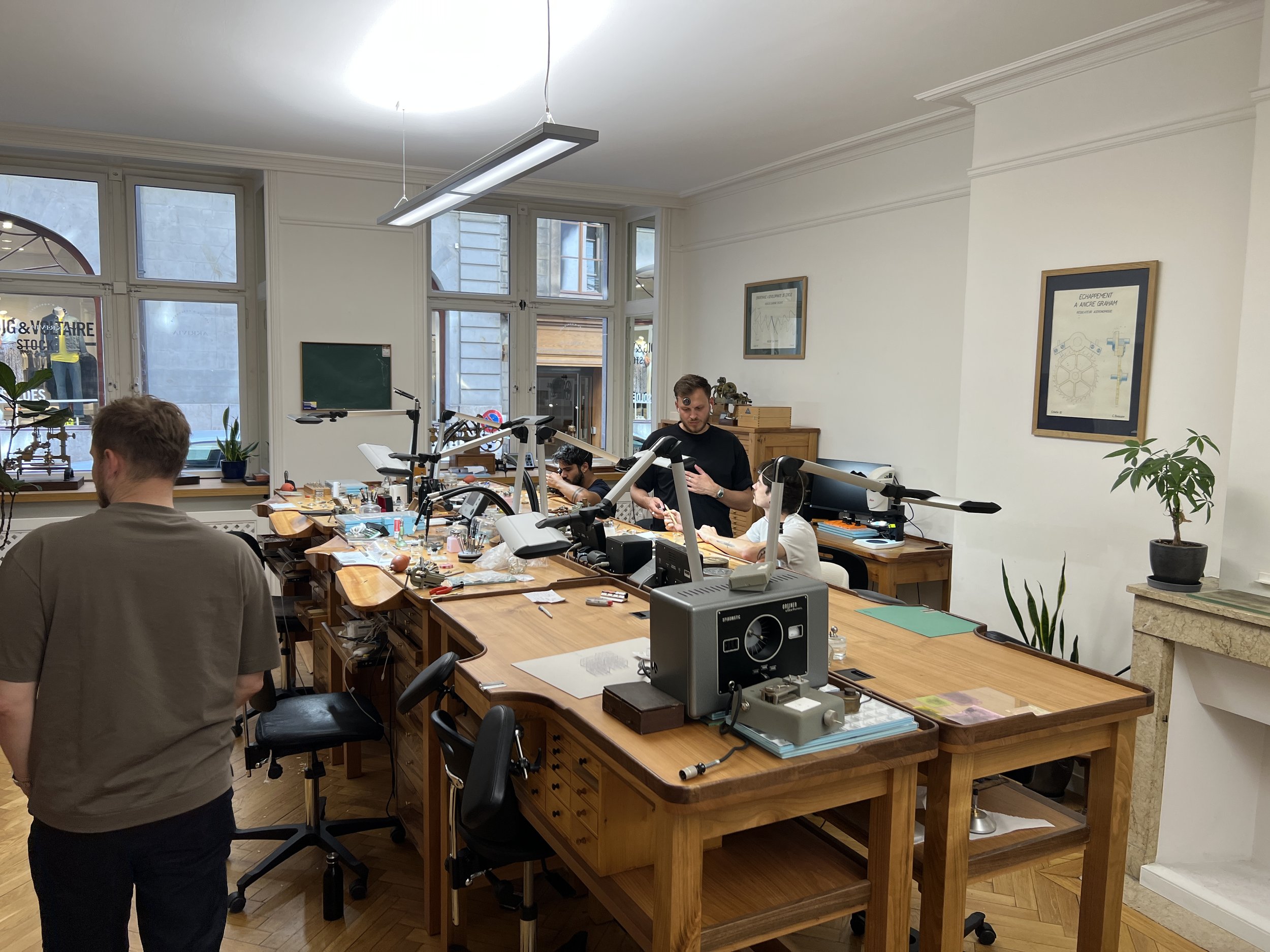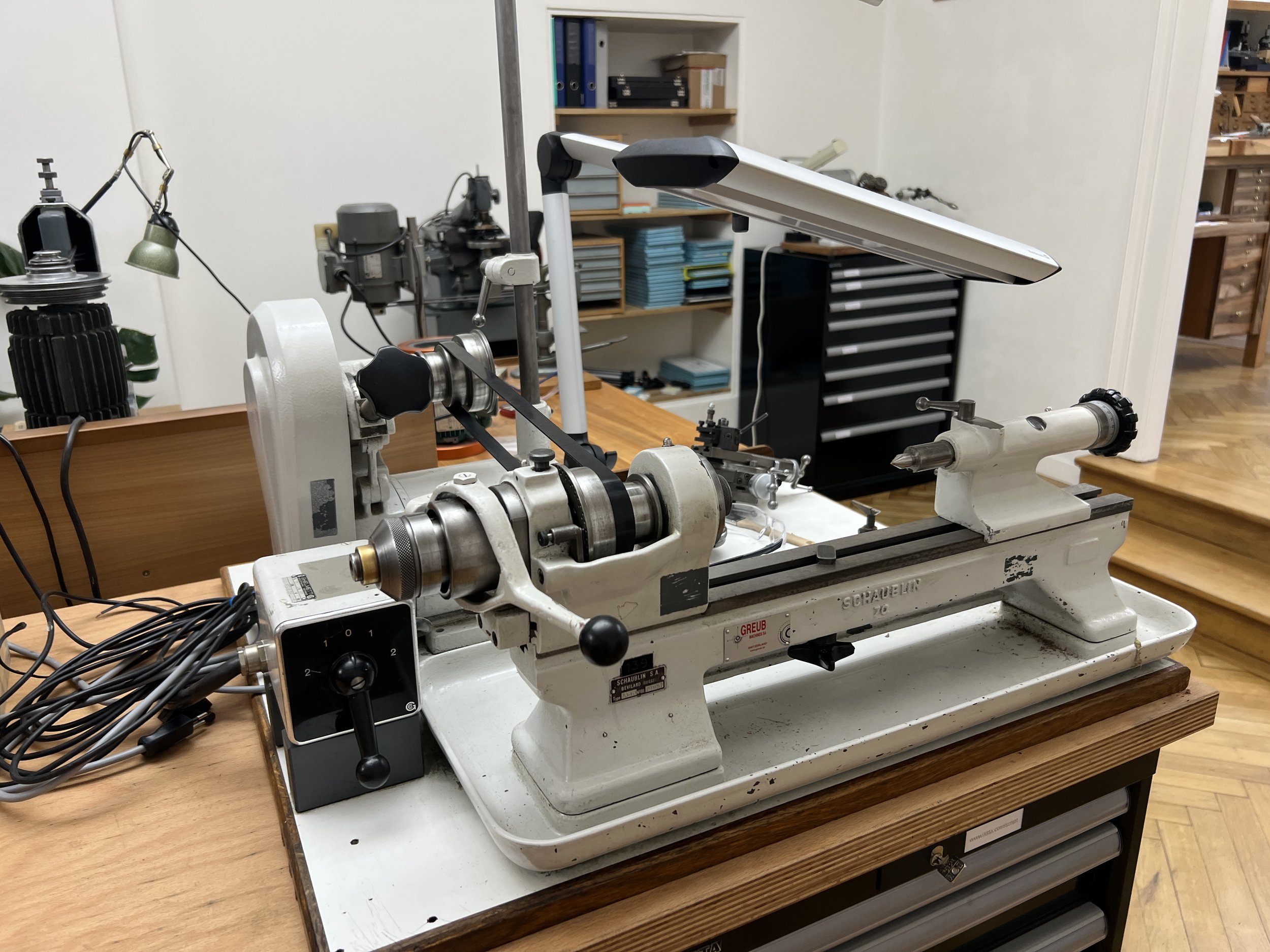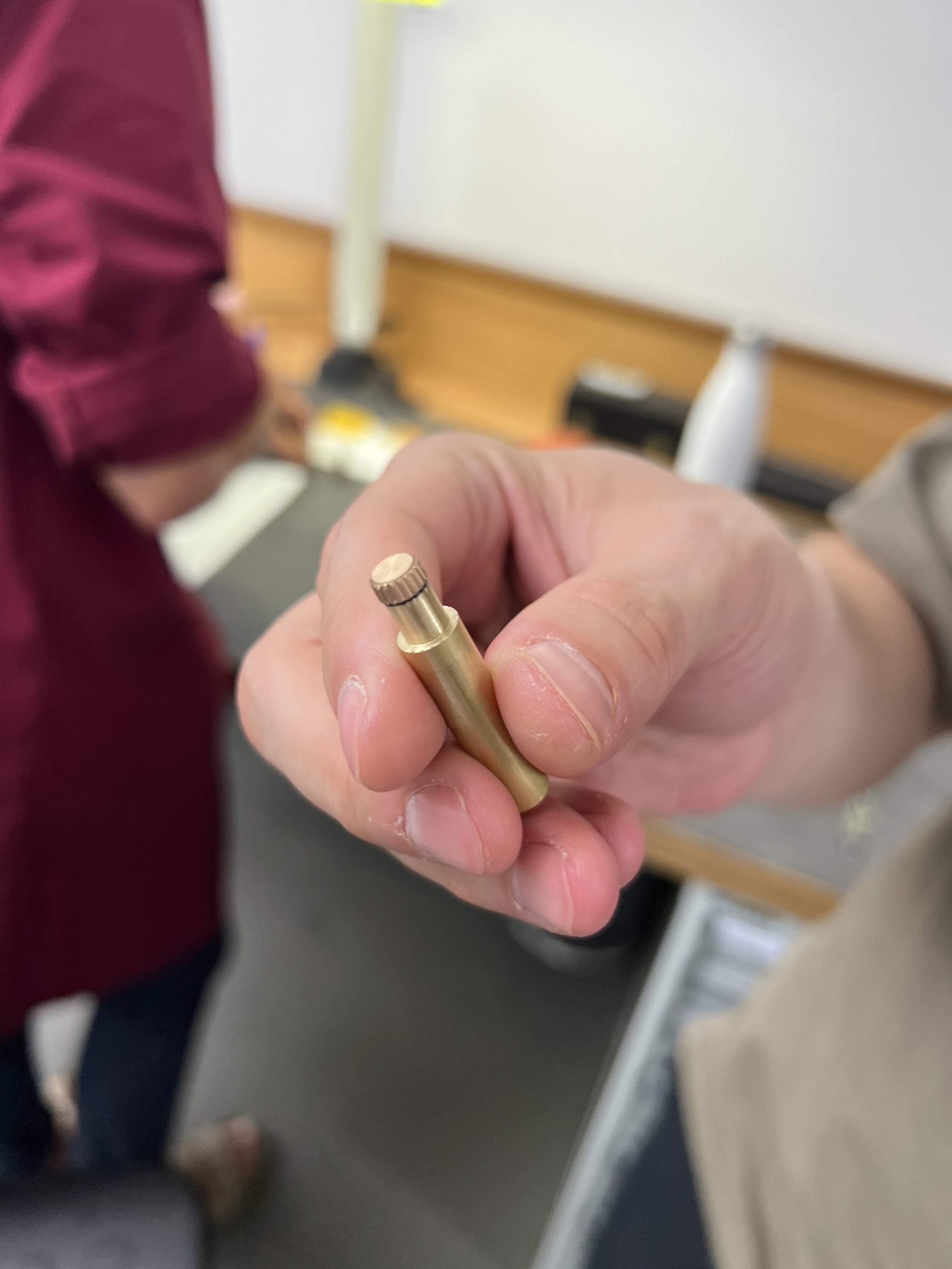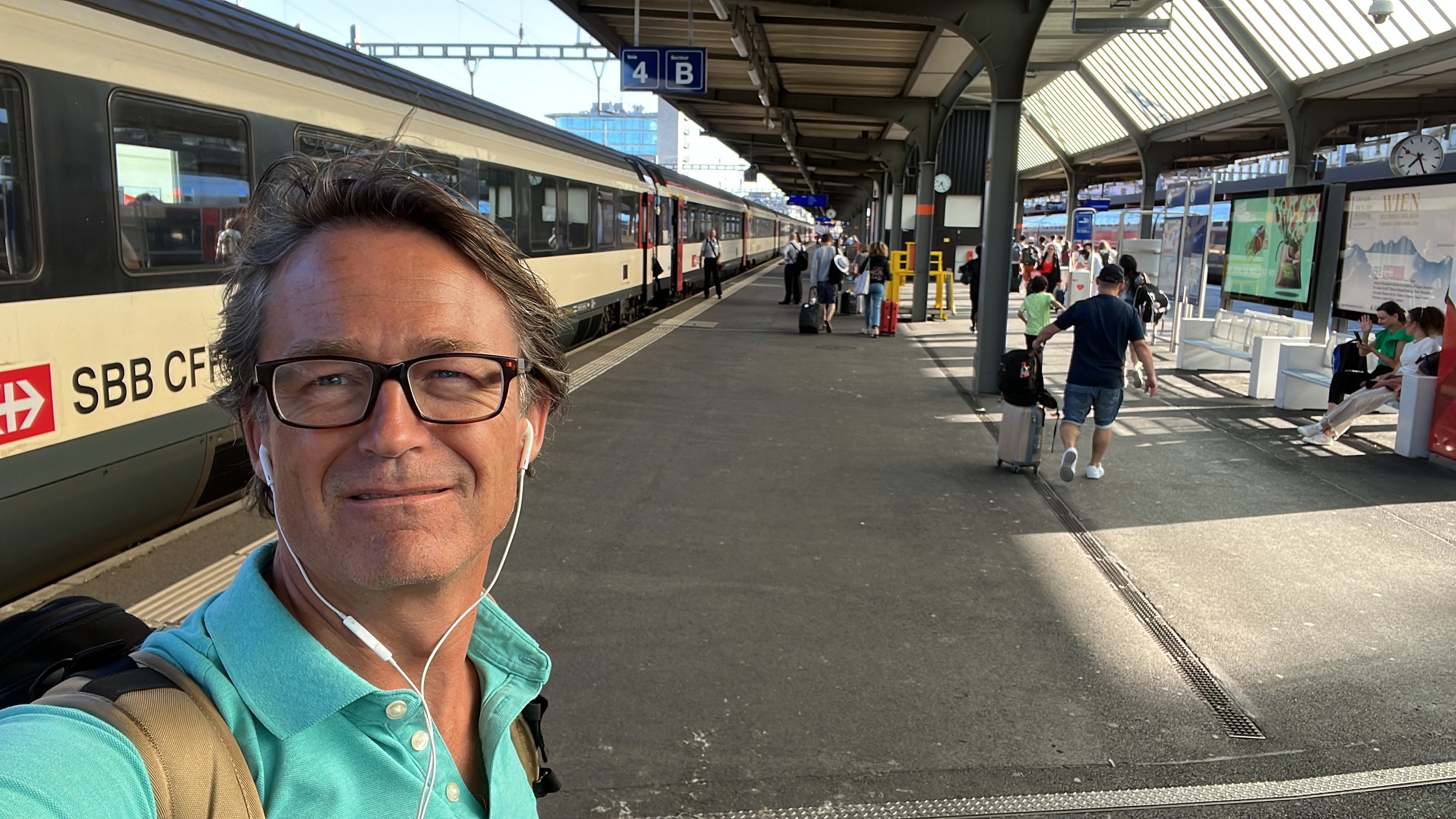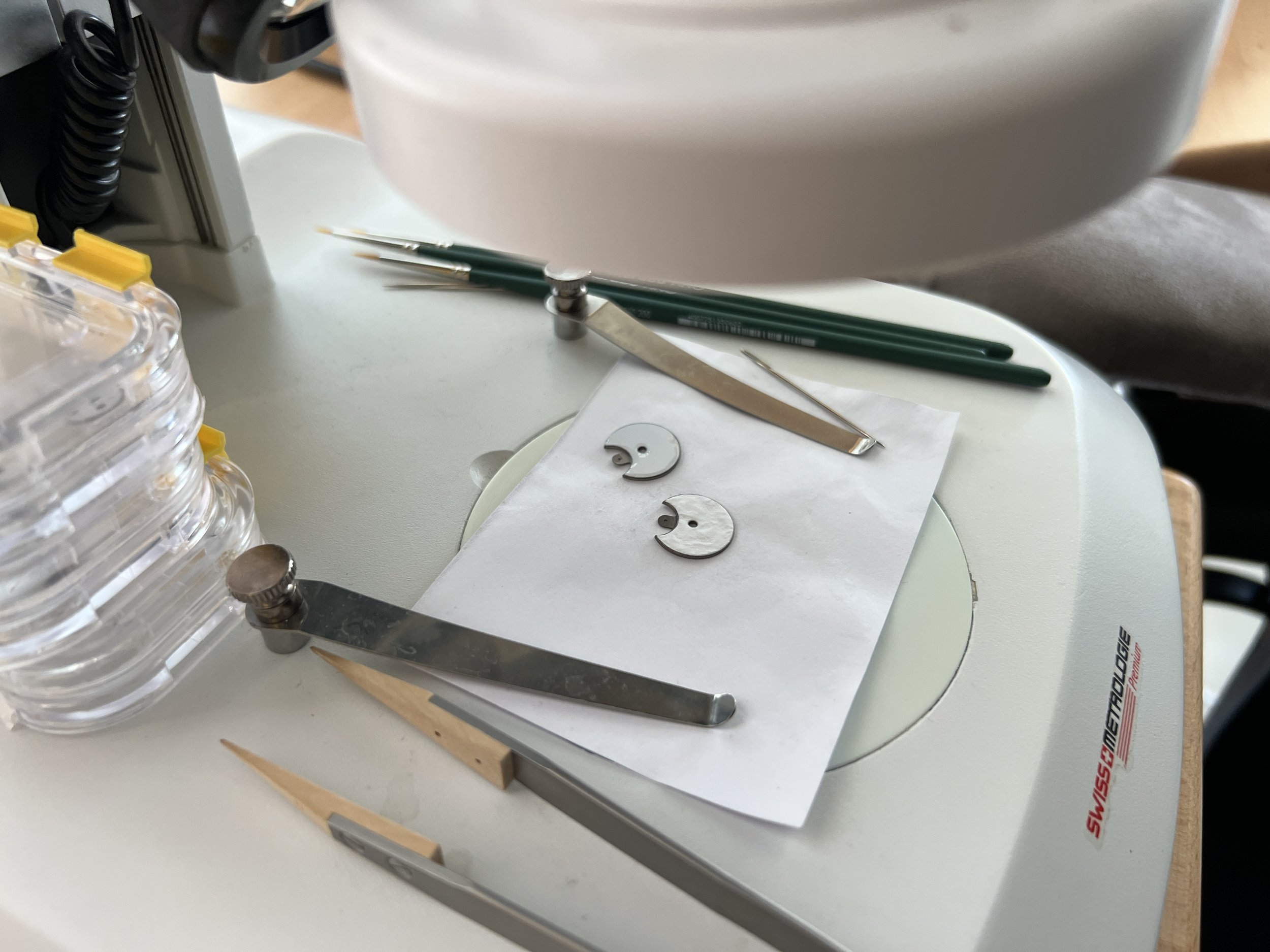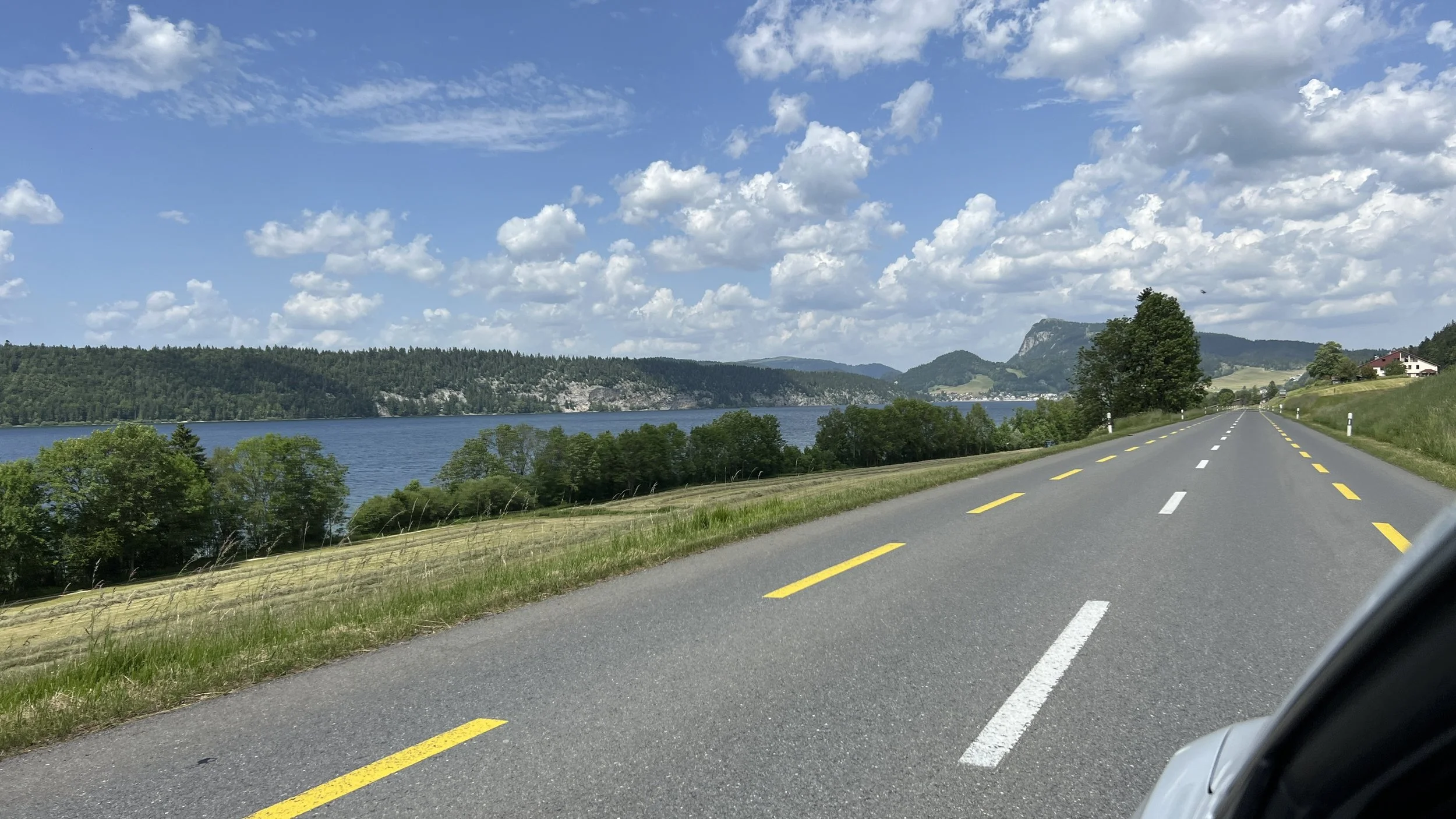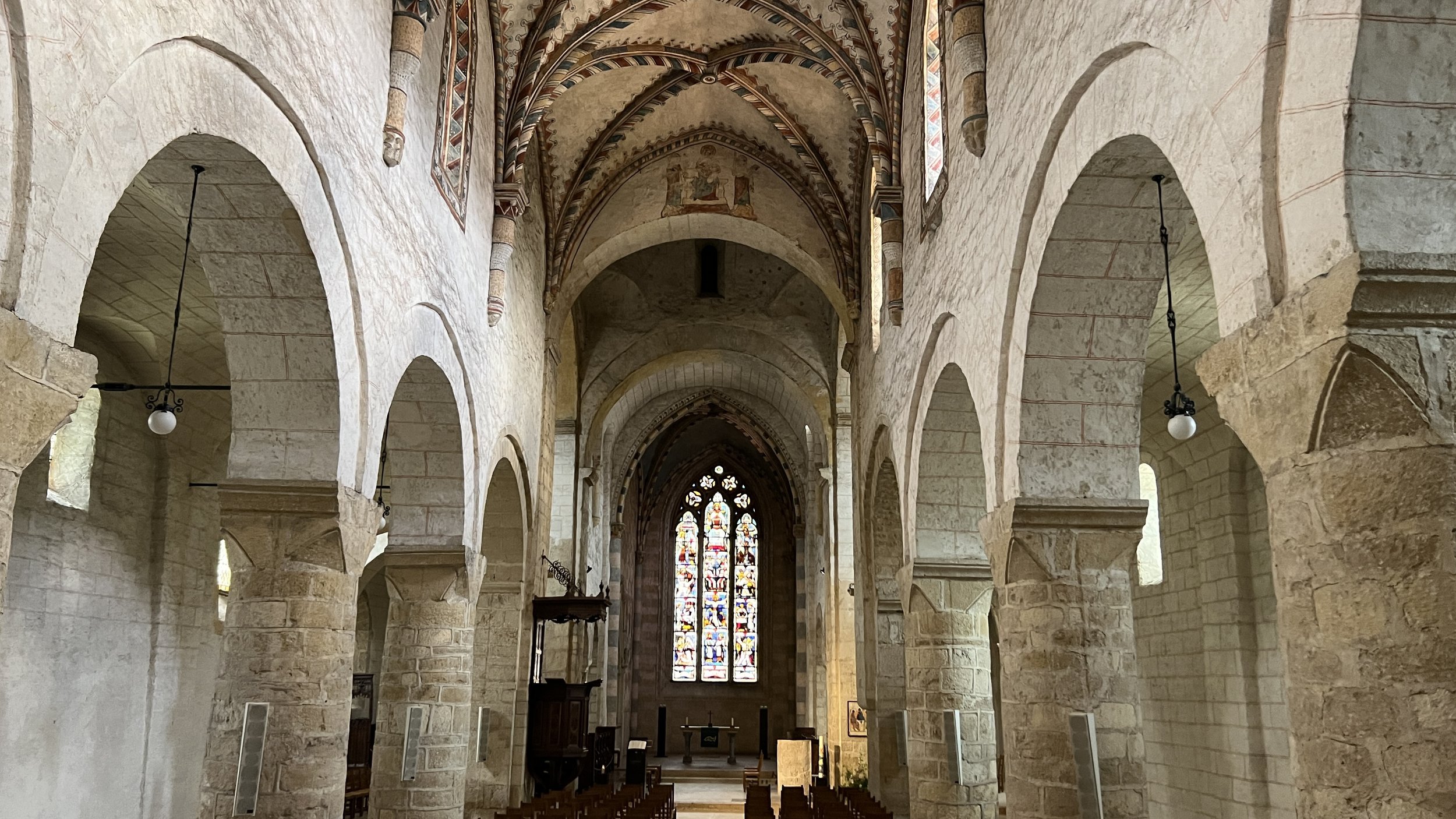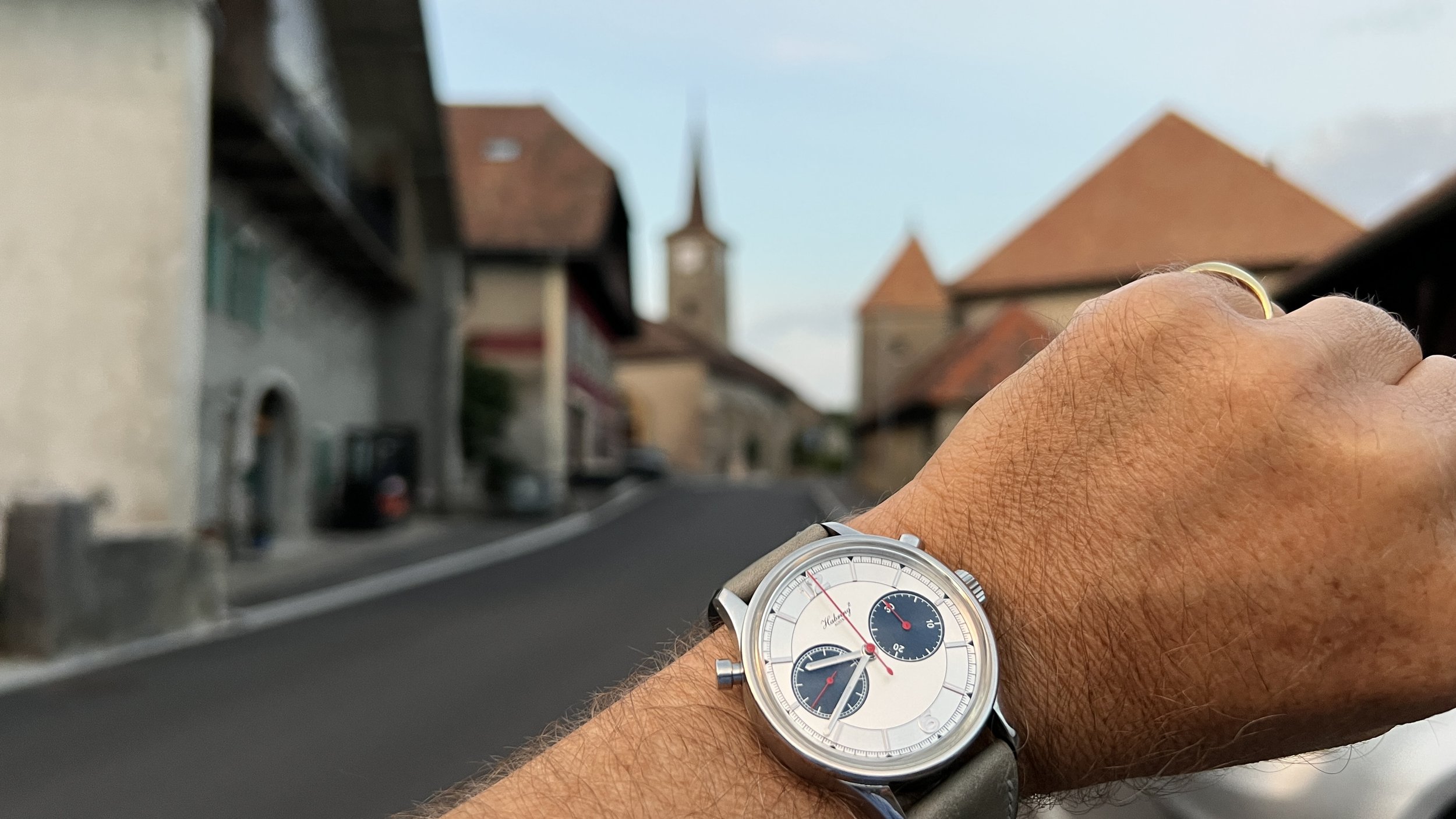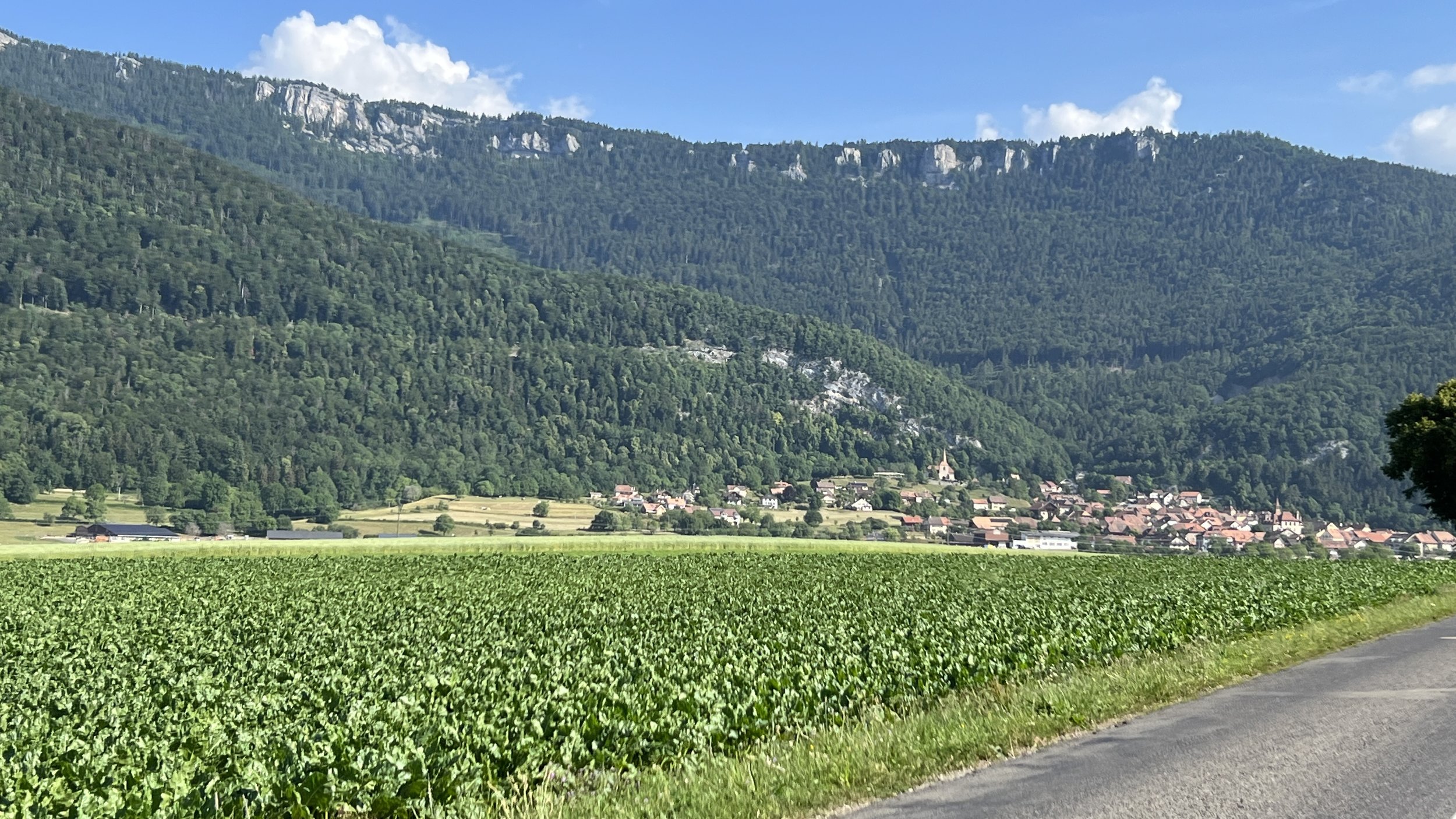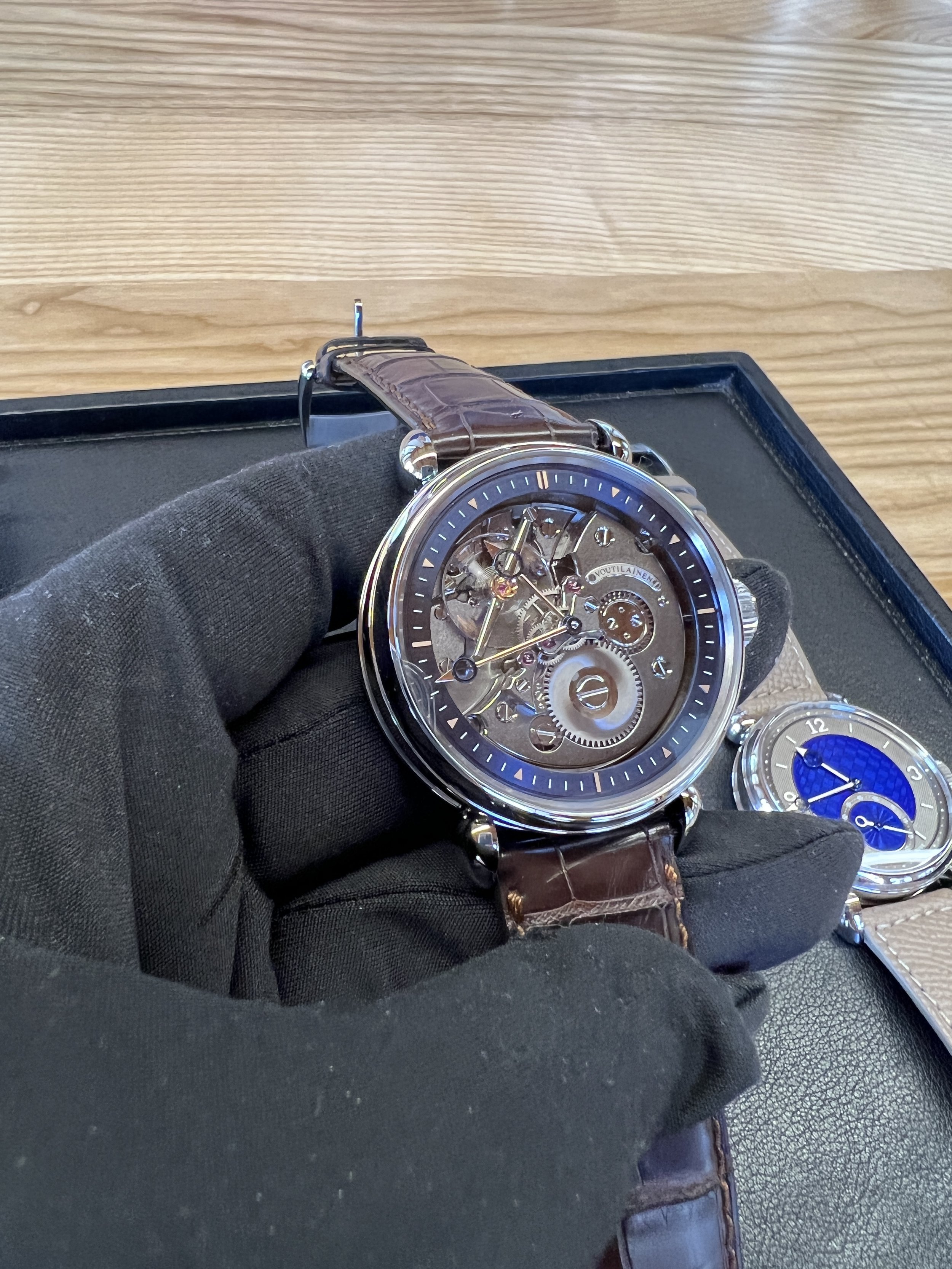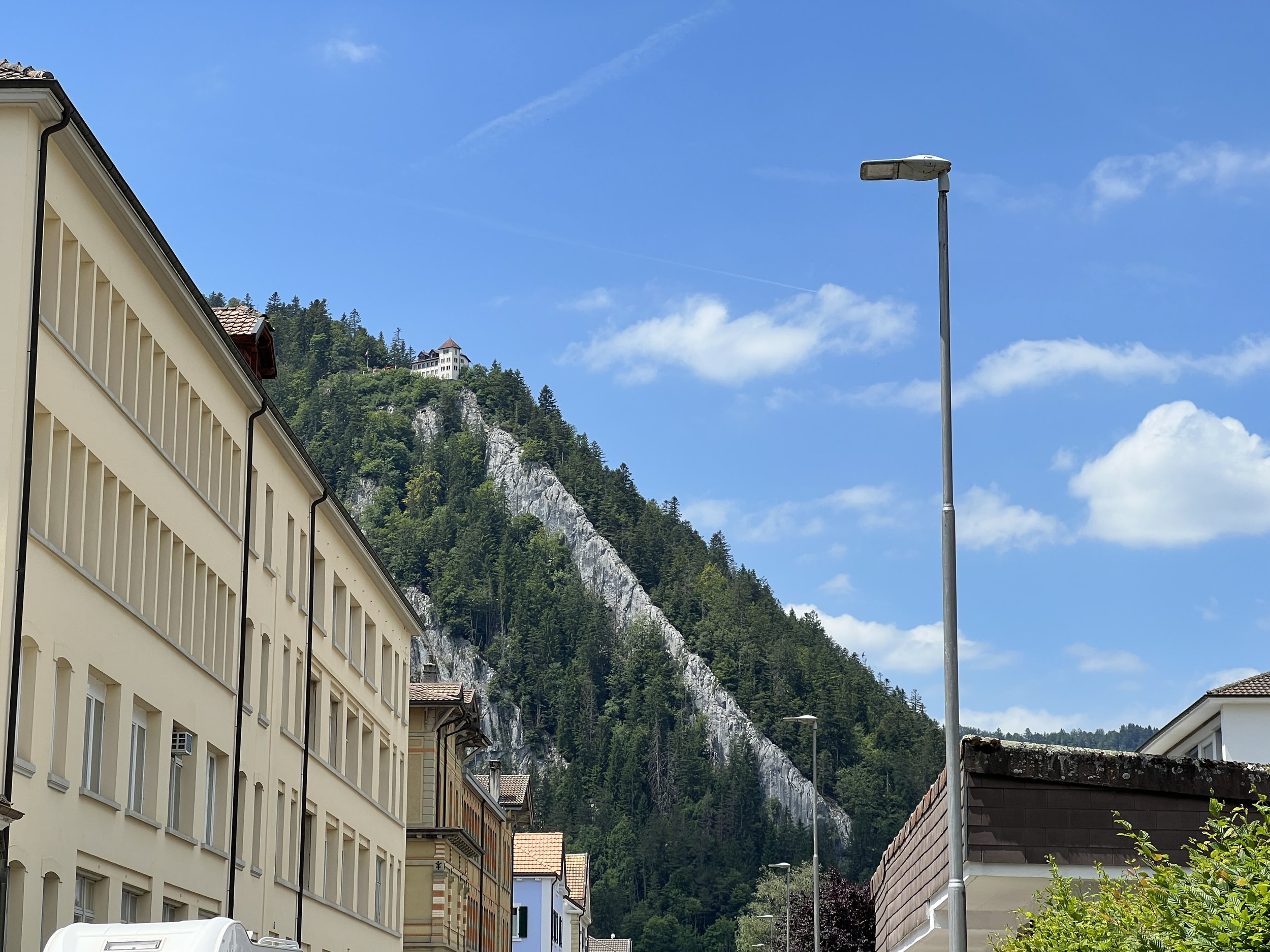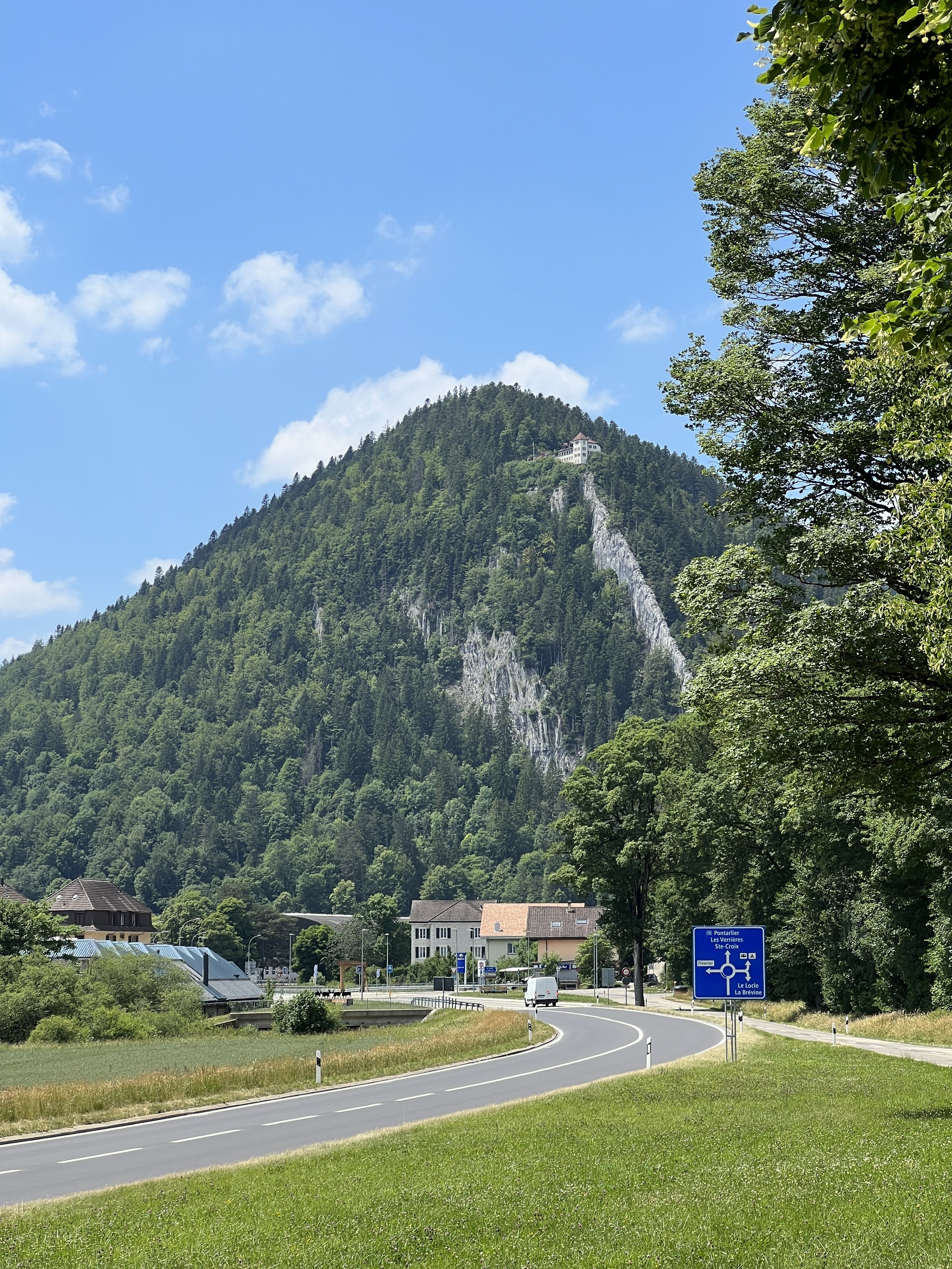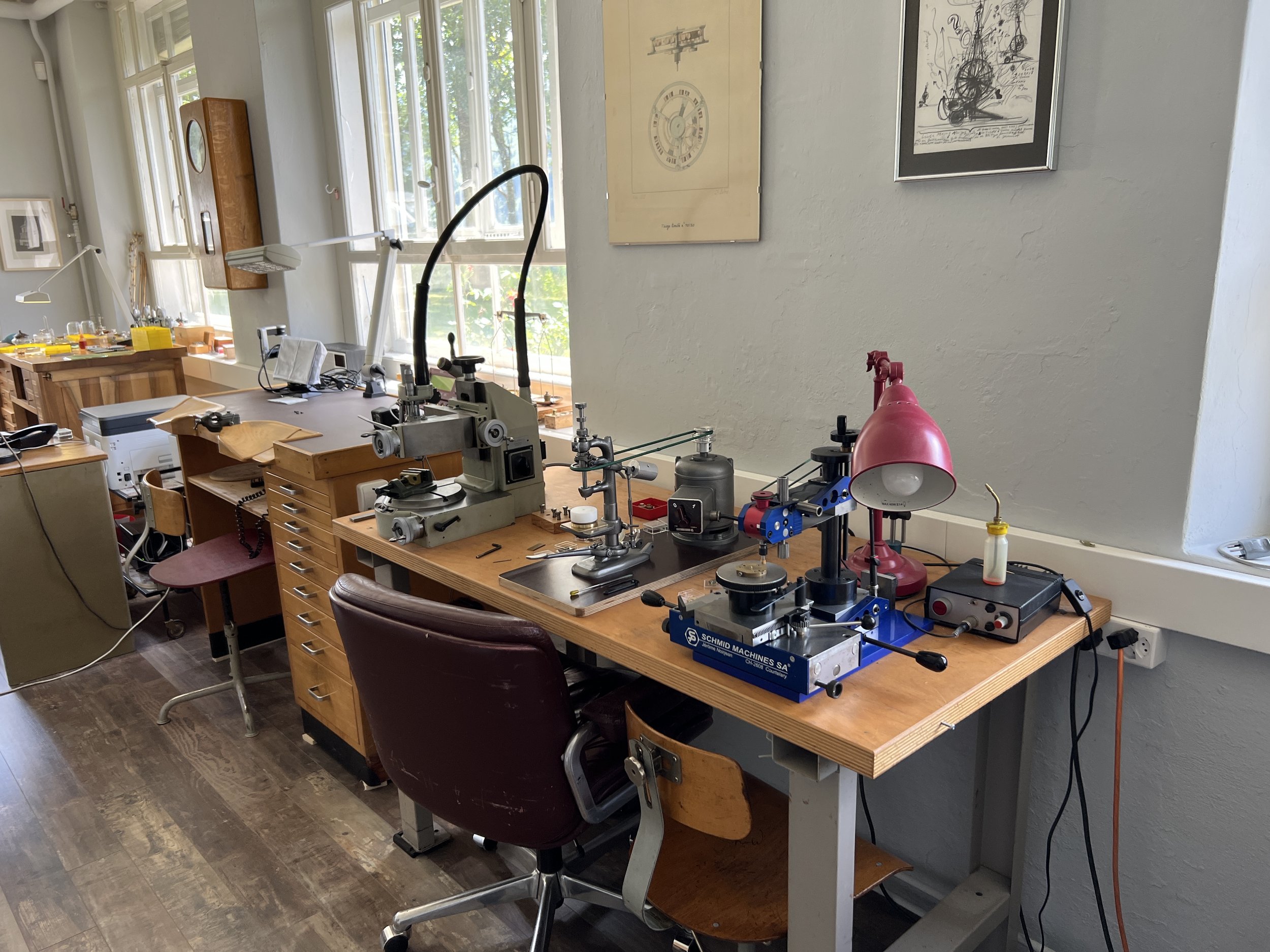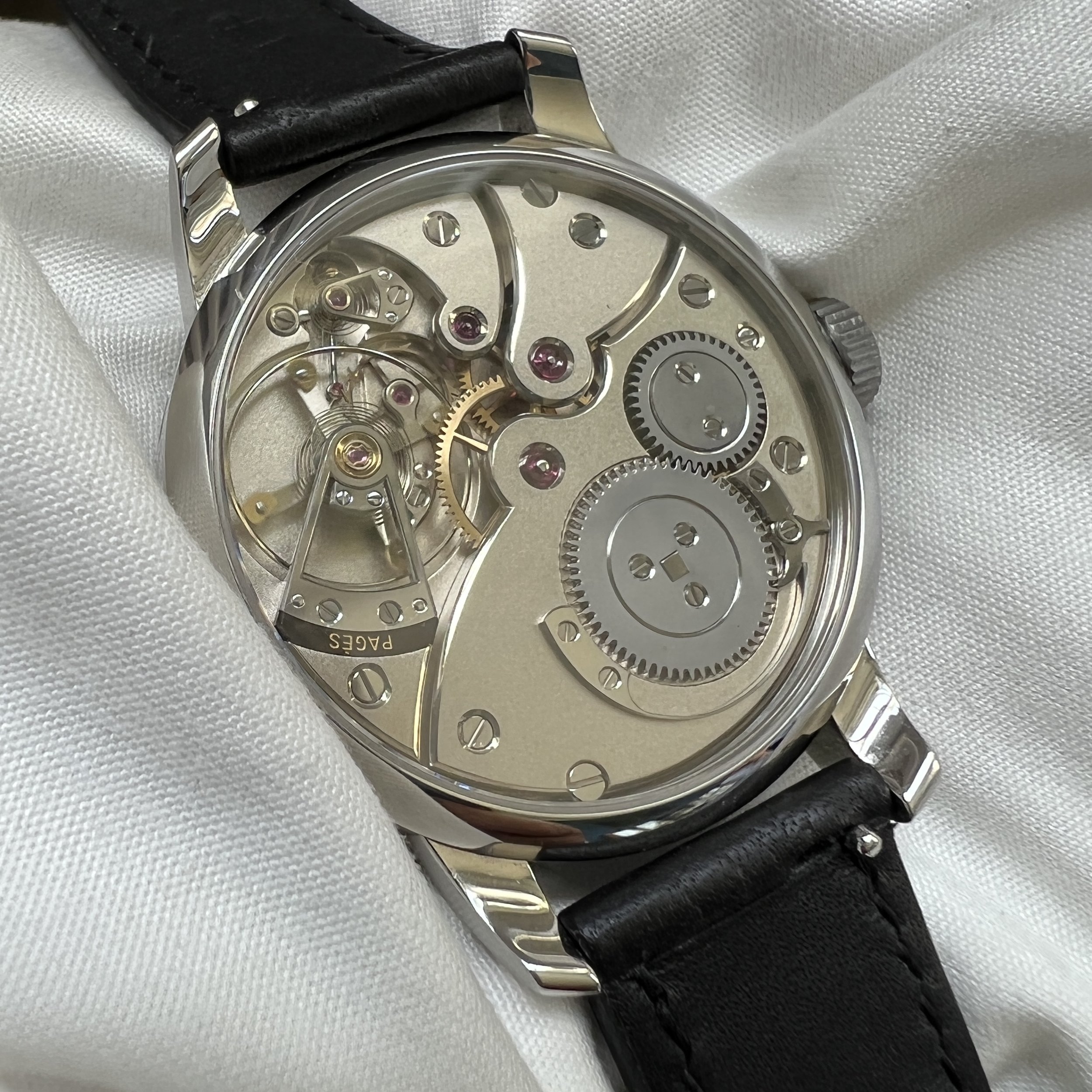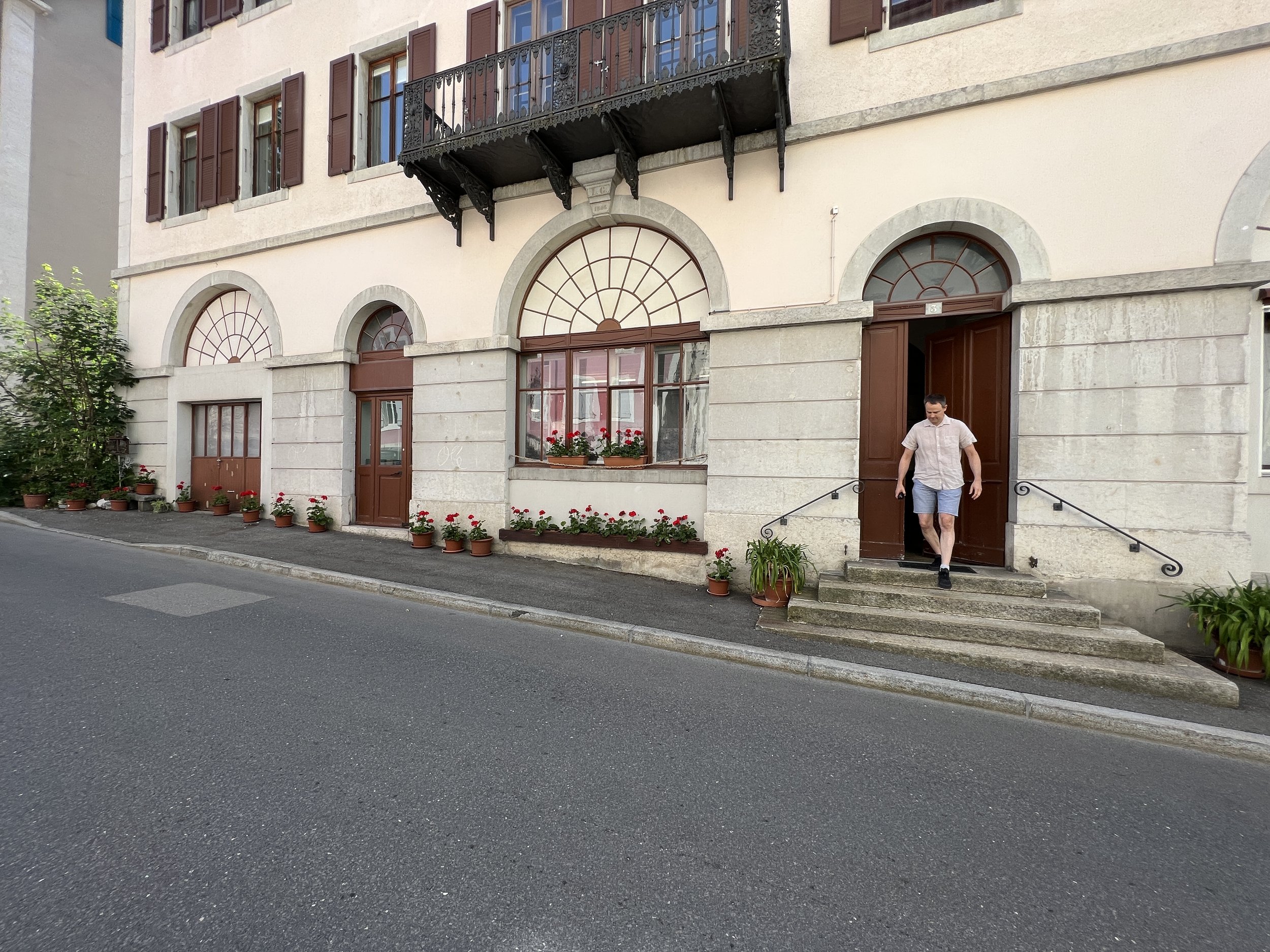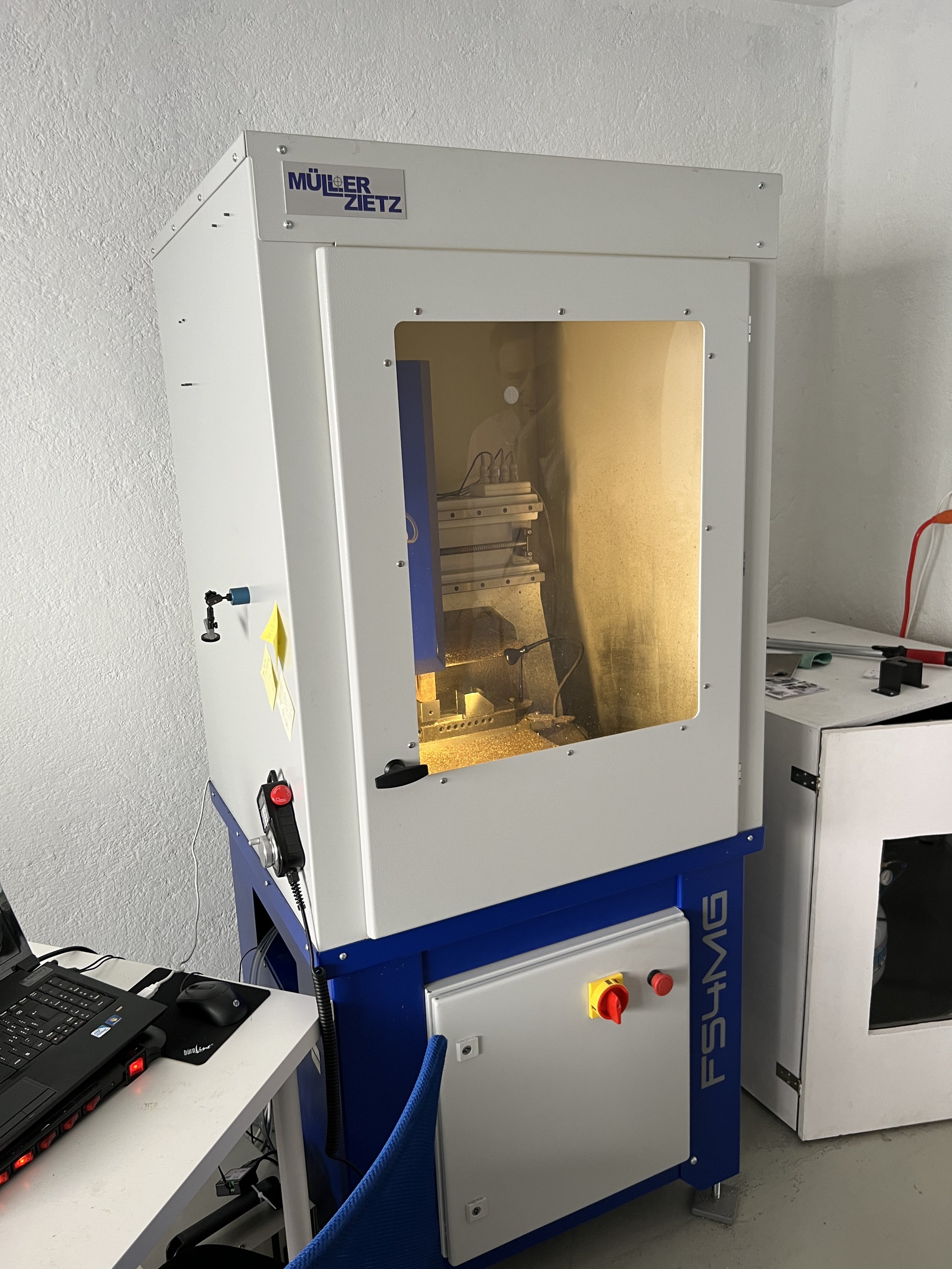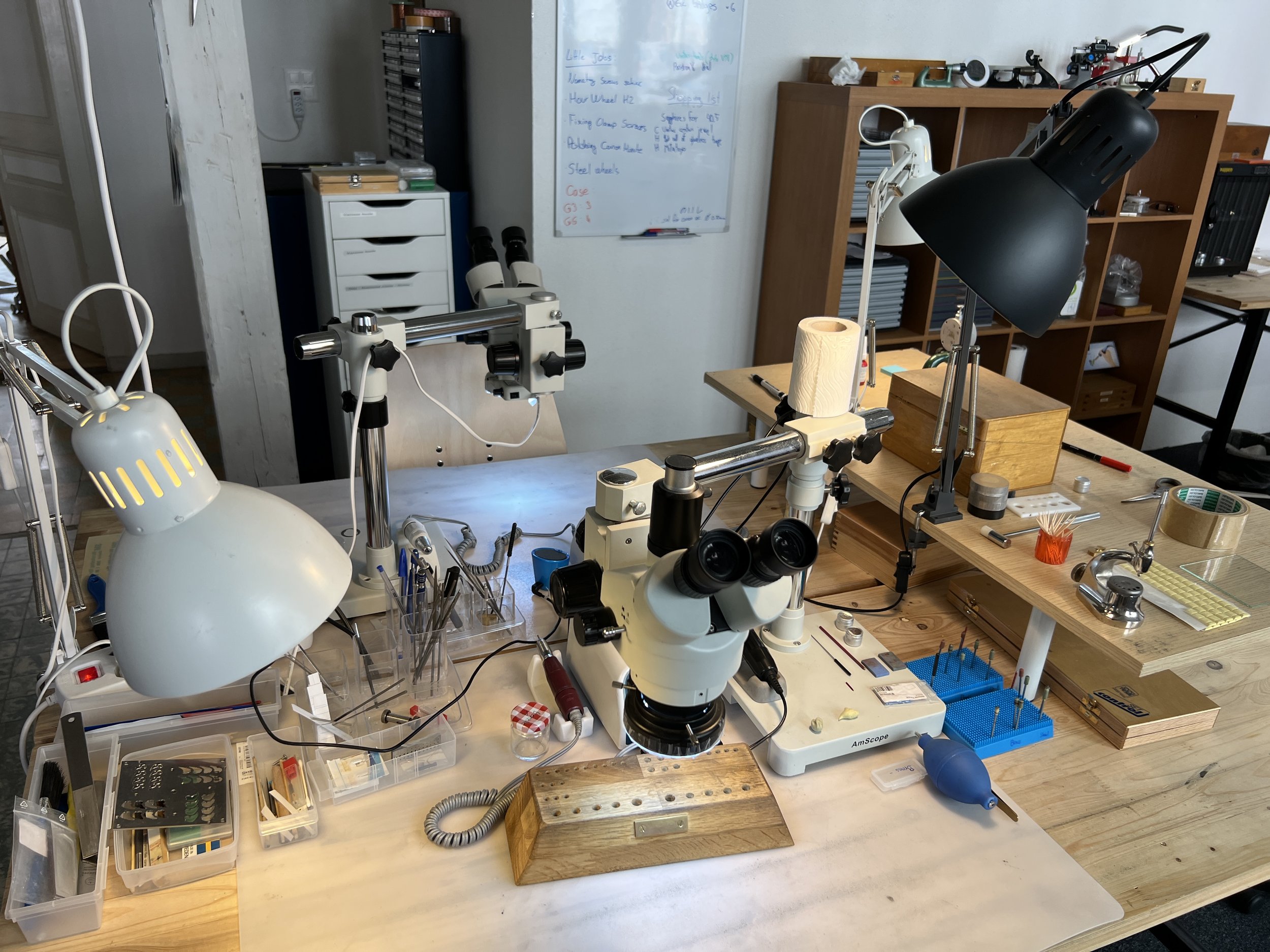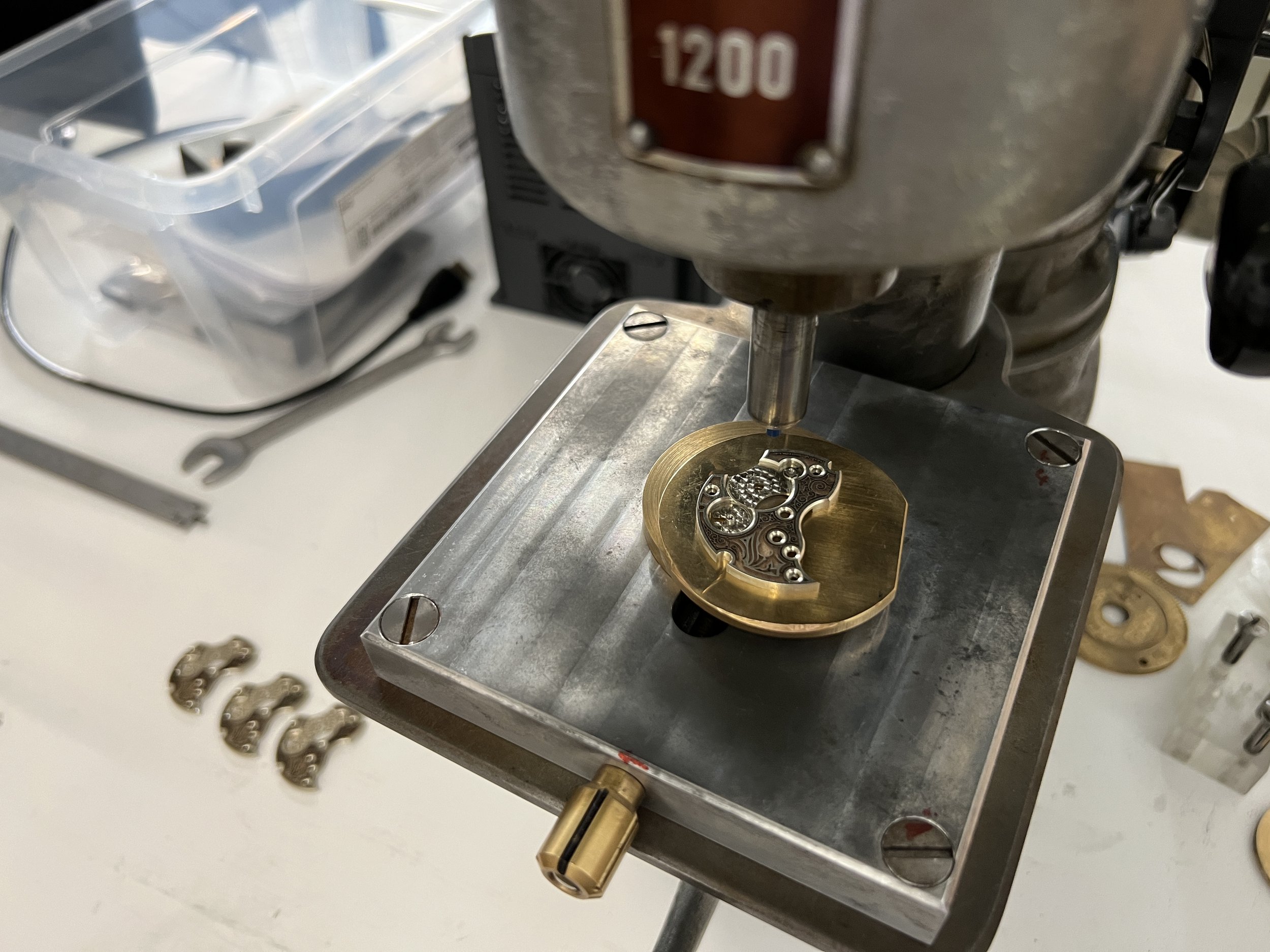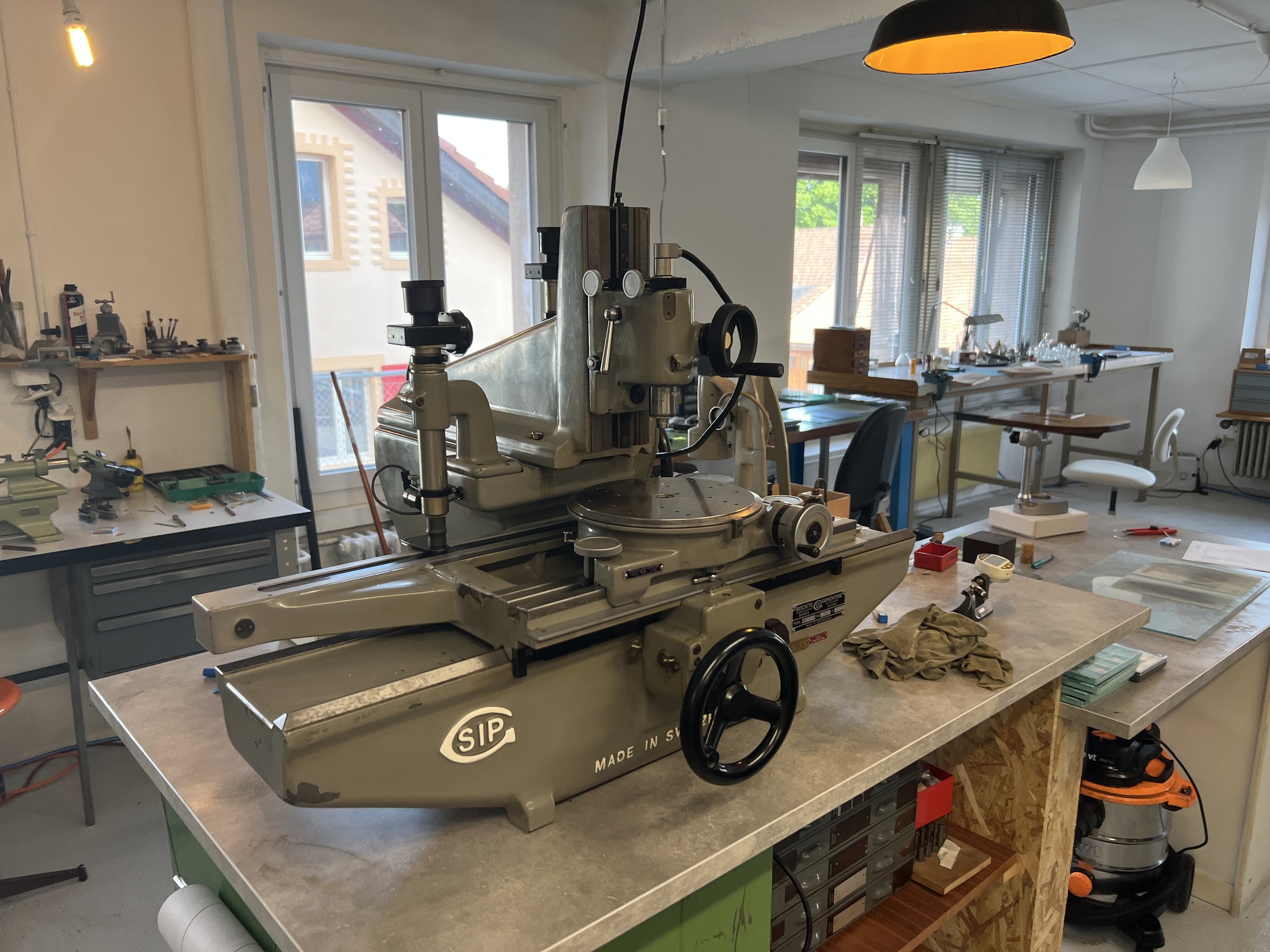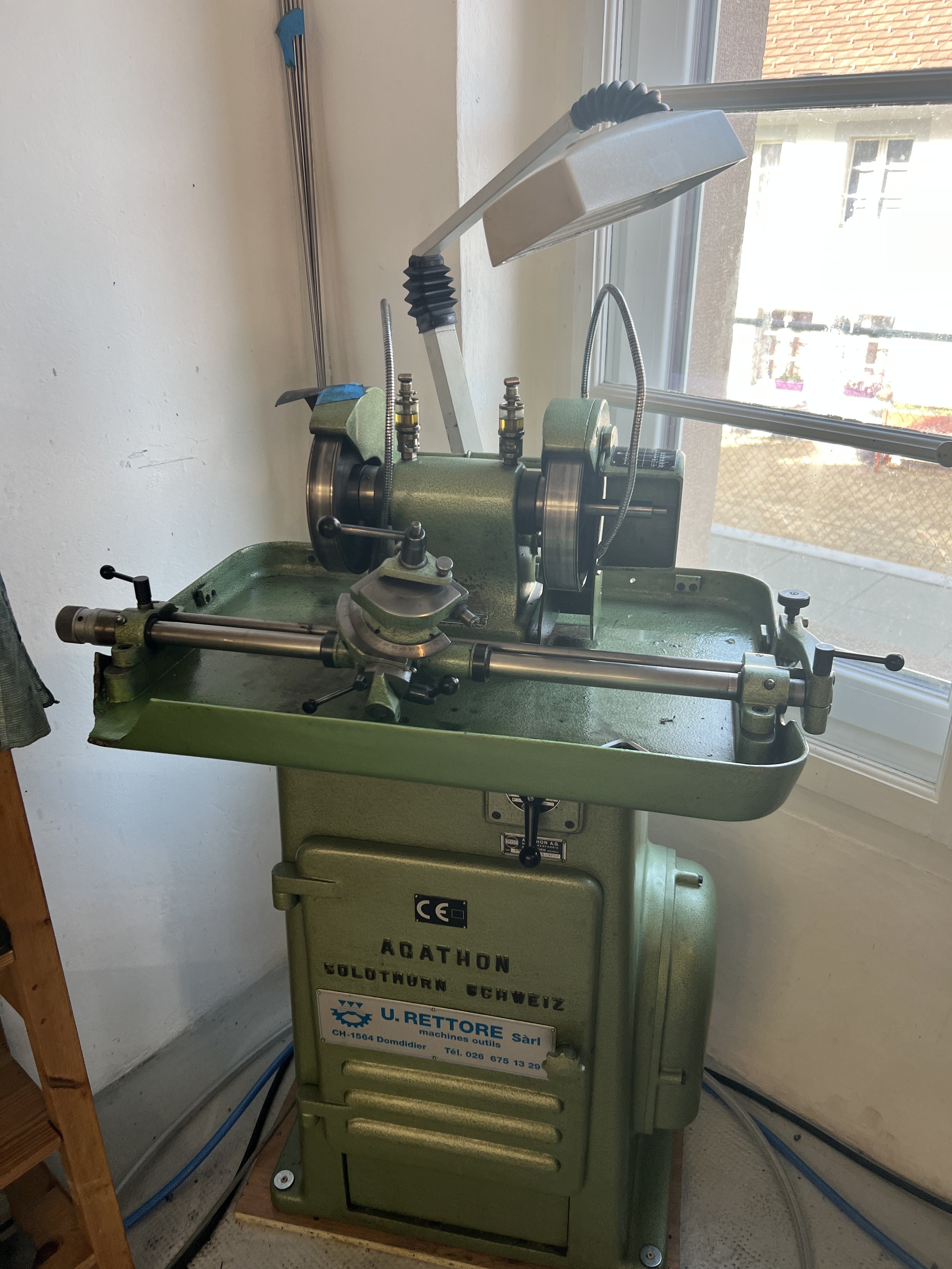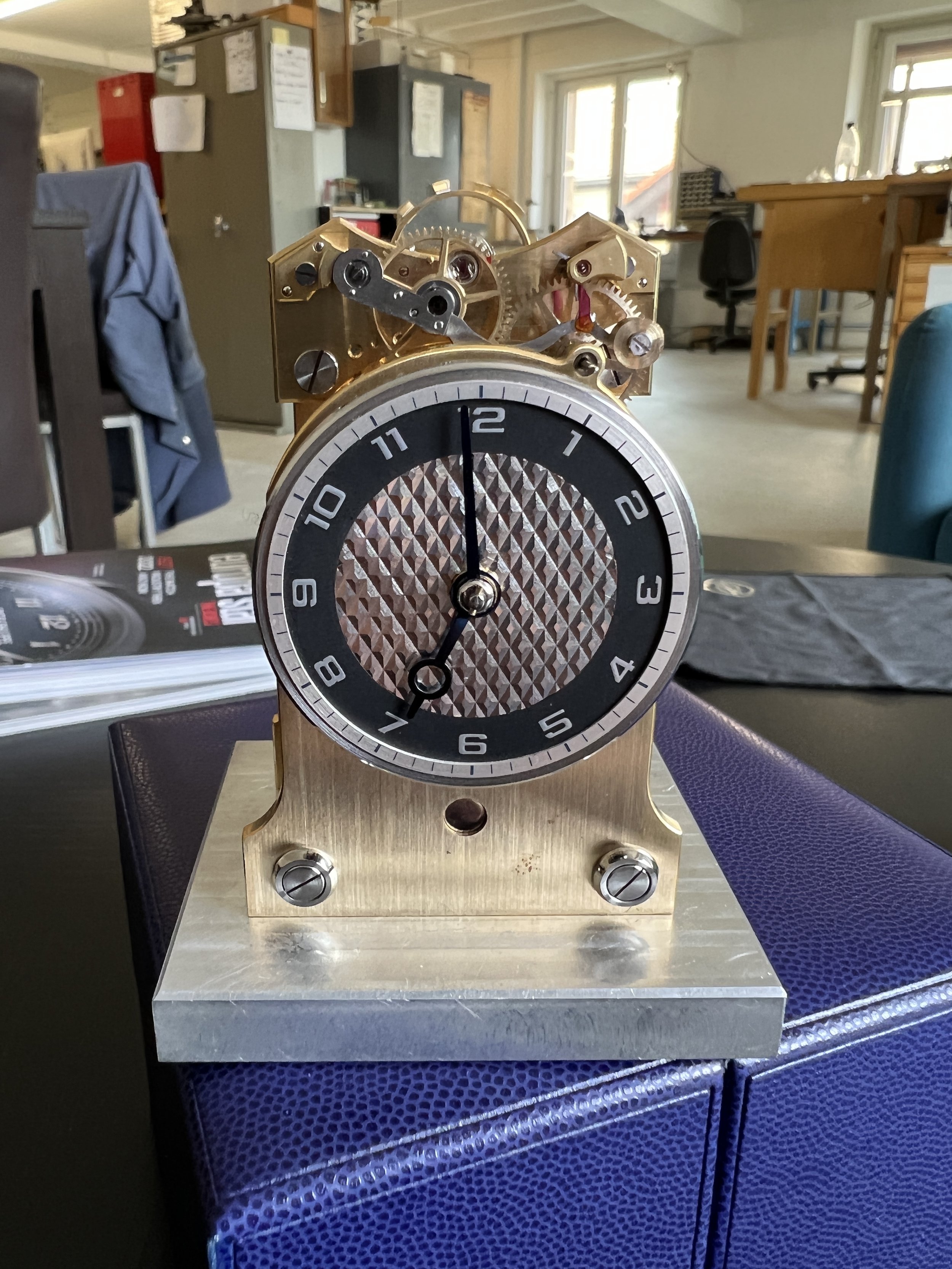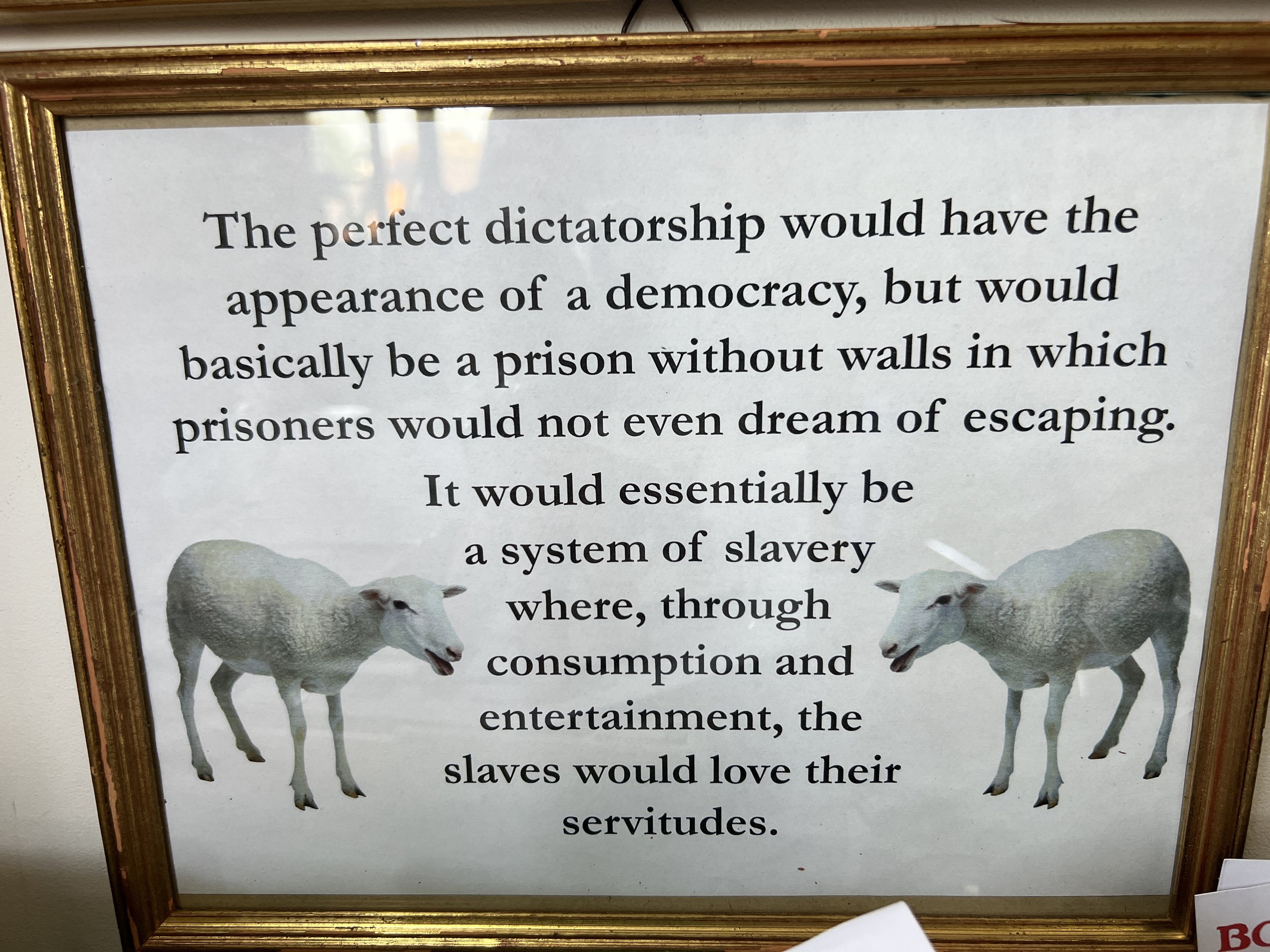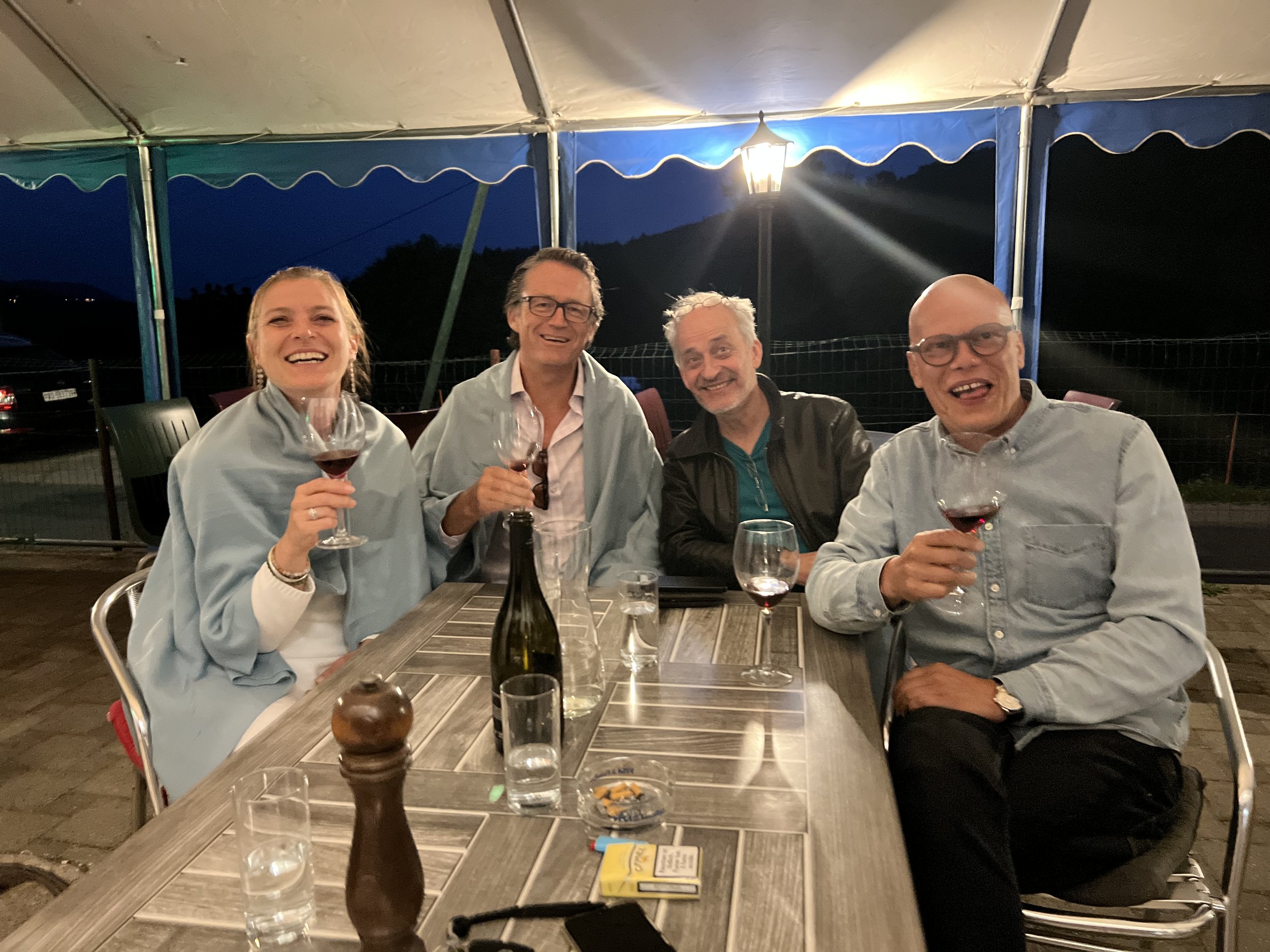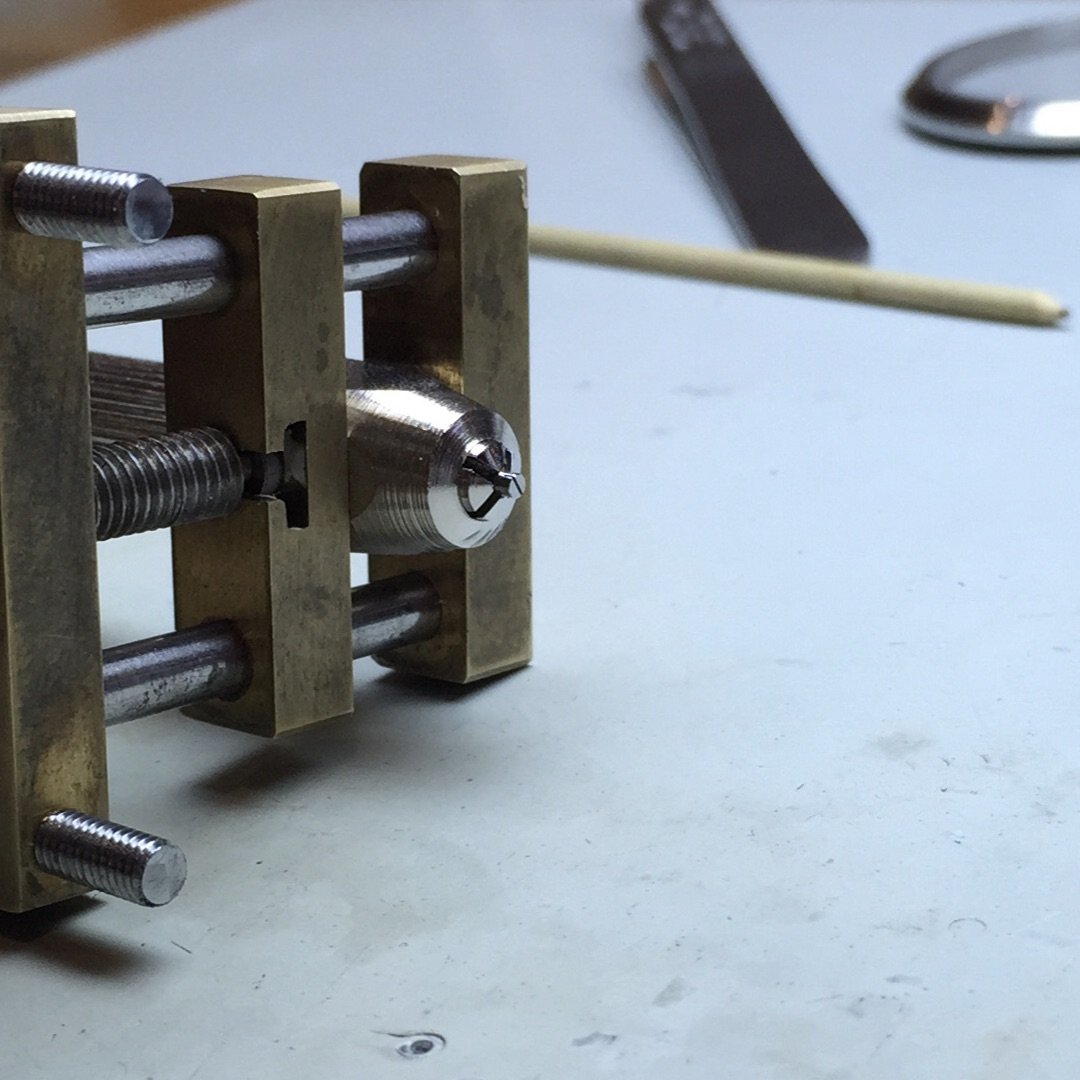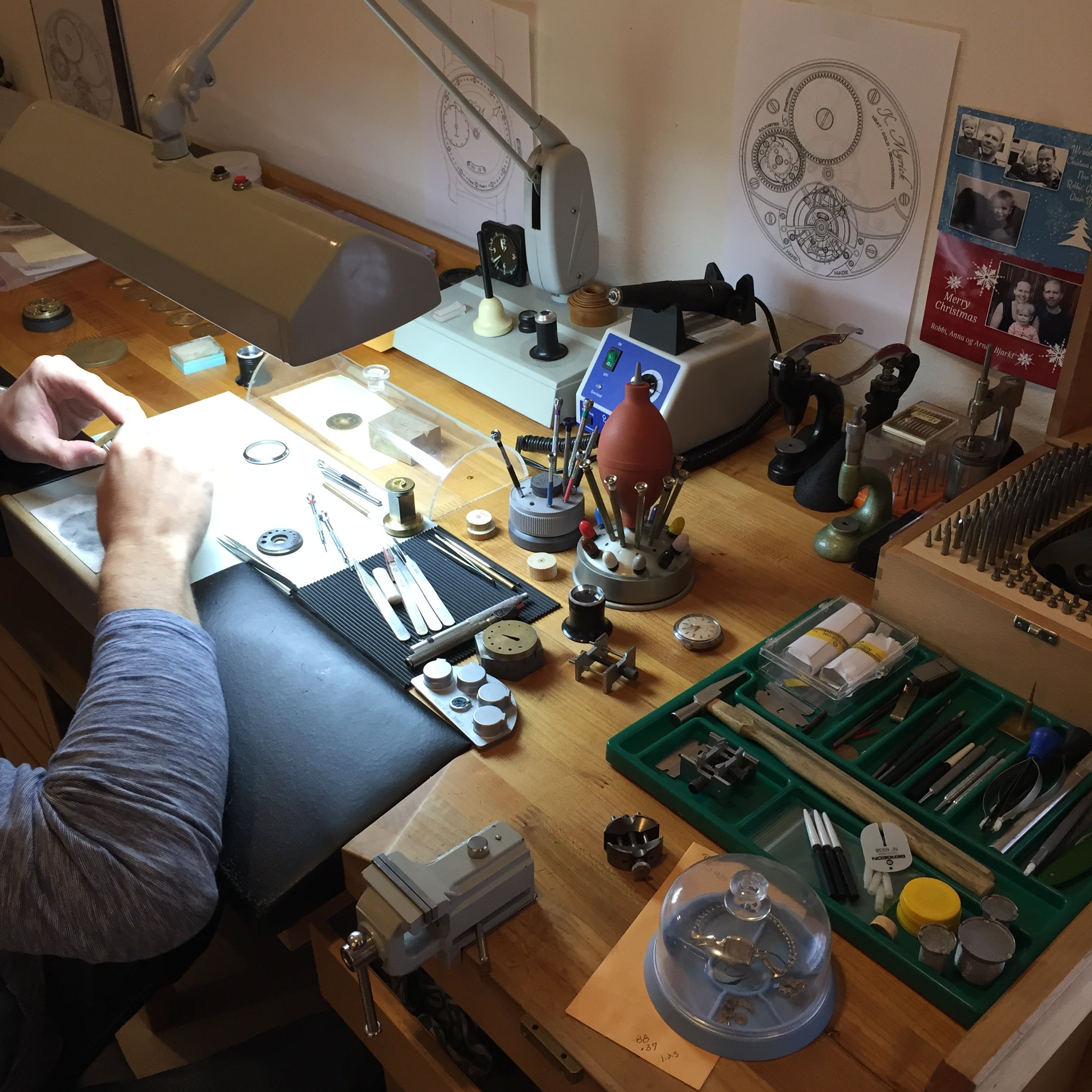Part One:
Well covid and pretty much all of it’s restriction had finally been lifted, so a long over due visit was planned in May and I made the trek in July 2022, to Geneva to begin an 8 day Independent Watchmaker tour. I landed in the early evening on a Monday and headed straight to my favorite restaurant, L’Entrecote off the Rue du Rhone for what I can only say is a hedonistic experience. Simple pleasures for this Englishman! Having satiated myself on some of the finest Steak Frites, I retired to bed a happy fellow.
The following days were to be full on, touring initially Geneva and then on to the famed Vallé de Joux, followed by Fleurier, Le Locle, Les Brenets, La Chaux de Fonds, Sugiez, Bienne and back to Geneva. I was joined on this trip by my trusty Habring2 Doppel chronograph. Austria’s best independent watchmaking company that I’ve been the pleasure of being an AD since 2005 when I began representing them in the USA.
Heading to dinner in Geneva
DAY 1:
Tuesday morning up and off for a morning walk and breakfast prior to heading up to Old Town to hopefully find the elusive Rexhep Rexhepi in his workshop. As fortune would have it he was indeed there and recently back from Japan, he kindly agreed to meet me later in the day when he had some time to give me. What is a watch nerd to do in Geneva with 4 hours to kill? Initially I popped into the old cathedral in Old Town, St. Peter’s, for some restorative peace and quiet. Meditative time in a stunningly beautiful chapel energized me for a visit to the Patek Philippe museum, a 15 min walk across town in warm muggy air. The Patek Philippe museum was well worth the effort and I’d highly recommend it to anyone interested in the field of horology. It has to be up there with the finest collections of important pocketwatches and wristwatches anywhere worldwide. Set aside a good couple of hours at a minimum, in order to take it all in. You won’t be disappointed.
The Patek Philippe museum in Geneva, a must see for any horology enthusiast.
Leaving there with my head swimming with horology overload, I walked back to Old Town to meet up with Rexhep at our appointed time of 4.30pm. He greeted me with that comforting smile and we sat and chatted for 15mins prior to me getting to tour his two workshops.
Akrivia’s atelier in Old Town, Geneva
Rexhep by his bench.
There is a finishing and assembling atelier/space where the Akrivia “magic” happens, Rexhep’s bench together with the “Front Office” and client meeting room on the north side of the Grand Rue in Geneva. The south side, almost opposite is the workshop filled with machines for prototyping and manufacturing parts and specialist tools for the machines.
The finishing and assembly area of the atelier.
Our old friend the Schaublin 70 lathe
Akrivia is making it’s own cases too, having brought out of retirement, the seasoned expert Jean-Pierre Hagmann to show them the way. There were several machines I’d not seen in a watch workshop prior and the one for pulling metal wire through a screen to make it a smaller diameter, was interesting.
The metal pulling machine, typically found in goldsmith’s workshops rather than watchmaker’s!
Lathes, jig borers and milling machines found typically in well appointed ateliers were all there! A recent acquisition was a rather elegant straight line engine turning or guilloche machine by R. Gudel SA from Bienne. Prominently sitting near the front of the shop, Rexhep assured me he was going to master this additional watchmaking art too.
The (new to Rexhep) straight line guilloche machine
The RG crown just off the milling machine
I got to witness a colleague of his milling a rose gold crown while I was there. His small team of engineers was also housed in this building, working away on their computers in CAD programs on the next pieces. I wasn’t allowed to take pics in that room for obvious reasons. We finished up and then headed out back to my hotel across the river. The following day was to be busy, picking up the rental car at Geneva airport prior to driving up to the Vallé de Joux, was the initial task.
DAY 2:
Yours truly heading to airport, via the train, to grab rental car
Wednesday morning, I am up early and eager to get going to the Vallé de Joux. Renting a car at the airport seemed a good idea when I made the reservation, however I wasn’t about to drag my bags through Geneva by foot and then onto a train to the airport and walk to the car rental parking lot. So, after I made the trek up and had picked up the rental, I then proceeded to drive down through Geneva and it’s one way streets to the hotel to grab my bags. This proved much more tricky than I anticipated. I found myself rather quickly across the river having to drive through several “Pedestrian Only” streets in order to get back across the river to my hotel to grab the bags. After that experience, I realized why it is best to not drive into central Geneva if one can possibly avoid it! Once the bags were finally obtained, away I went heading north east for the town of Le Sentier to meet up with Romain Gauthier. A hour or so up in the Vallé de Joux. I took the route my Google maps suggested and it was a fabulous drive up narrow twisty hillside roads with lovely views.
As I headed down into the Vallé de Joux
Arriving into Le Sentier, I passed many venerable watch house manufactories. This really is where the “sausage is made” AP, JLC, Breguet to name a few, with many specialist makers in the watchmaking space located in this valley. I was eager to visit Romain’s manufacture, having met him originally in 2009 and began working with him soon after arriving in San Diego. His Logical One model was and still is for me, one of the top watches ever designed and made. Pure genius from an engineering and aesthetic standpoint. Ahead of its time, Romain tackled the issue of Constant Force with his interpretation of a system developed many moons ago and he improved it with his engineering mindset. When he showed this watch in Baselworld in 2013, I was immediately moved by it. Excitedly texting two great Independent Watchmaking enthusiast clients right after the meeting in Basel, I got their agreement to order them their platinum watches. His initial series offered were 20 pcs in platinum and 20 pcs in red gold. I know these 40 watches were probably not going to last the show without being sold out. It wasn’t like the crazy times we now find ourselves in, where a watch of this brilliance is sold out in a matter of minutes of it being announced. However, back then in 2013 I had that feeling that I was looking at a watch that would truly get collectors attention. I’m pretty sure the two chaps who now own those two watches are pretty thrilled to have had the opportunity to acquire them. It’s why I do what I do, and I derive enormous pleasure from connecting collectors with special pieces like this. Access to the top pieces is getting more tricky as many folks are finding out in the current market. Tiny quantities make for a sellers market and gaining access for collectors is the old story of who you know. I digress, back to the Vallé de Joux!
One of the 20 original LogicalOne models cased in platinum
Romain greeted me outside his atelier and we immediately dove straight in the tour of his manufacture. Impressive to say the least, he has created a watchmaking business that not only supplies his own Romain Gauthier watches with raw parts, but also is a specialist manufacture of parts for other watchmaking houses. Most traditional parts makers require big quantities of parts for orders, Romain saw a niche when he was doing his MBA, and took the opportunity to fill this missing part of the supply chain in Switzerland. The machines inside are all Computer controlled and require high degrees of skill to even program in order to create the precise parts required in the watchmaking world. The tolerances required have become so fine that unless a micron tolerance is available, parts are not able to be used. Romain and his team have these skills and machines with which to execute to the required tolerances. This is a highly desired ability and his workshop’s production is in demand!
We then headed upstairs to the assembly and finishing area. This is another space where “Horological magic or wizardry” occurs. The degree to which his team goes in terms of hand finishing, using traditional tools and techniques, is truly impressive. Gentiane wood is harvested in the autumn from the local fields for the final polishing of the anglage on his watches. Again many tools of the trade are on display in the Finissage space.
Raw Gentiane wood
Where I find the real magic happening is in a small room inhabited by three ladies carefully hand polishing the anglage on parts by hand using the Gentiane wood and fine polishing compounds for the final mirror finish. This room also contained the bench where the hand engraving on the various bridges and plates occurs. The engraver was out for lunch when I was there unfortunately! Many parts where sitting waiting for her or his skilled hands.
The engraving station
Parts for a “C by Romain Gauthier” awaiting hand engraving
A close up of the titanium crowns that receive hand engraved stipling
Bridges for an Insight MicroRotor model
Next I wandered into the next door room where the actual assembly and timing takes place. Here the watchmakers assemble a watch at a time, this is not production line assembly like one sees in the big brands!
I got to examine under a microscope the final Prestige HM model ever made, that since this trip, I have delivered to a very happy client.
The caliber of Romain’s last HM Prestige model, this model was his first offering to the watch world back in 2007
A LogicalOne caliber on the assembly bench,
An Insight Micro Rotor on test
Near to this workspace is a closed-off office, that houses the highly specialized work area of Romain’s brilliant wife, Ana. She is the enameller for Manufacture Romain Gauthier, whose work graces the dials of his watches. Being able to bring this artisanal skillset inhouse is a huge bonus and allows for amazing creativity within Romain’s watches. That his dear wife creates these is another cherry on the cake for me!
Ana’s bench
Raw powdered enamel and paints, plus parts needing her skilled hands.
Enamel dials that Ana Gauthier crafts.
As Romain had other guests visiting from the USA, we had to cut short our personal catch up & visit, however, I certainly got the “full court press” tour of the manufacture and my appreciation has risen again for Romain and his watches. I bid him farewell and headed into the center of the village of Le Sentier for a late lunch to ruminate on what I had just experienced. Satiated I then headed North East along the edge of the famous Lac de Joux, stopping to dip my toes in, as the 85’F/30’C temperature had me feeling like taking it easy and not rushing too much. I had a couple of hours to kill before I wanted to arrive at my Bed & Breakfast spot in the village of Lignerolle. I had found on google maps what looked like an interesting old village tucked away with a 1500 year old Abbey. Romainmôtier didn’t disappoint and I got to spend 30 mins exploring the village and enjoying the old Abbey and it’s cooler interior! Well worth the trek!
Heading north east along the edge of Lac de Joux
Inside the abbey at Romainmôtier, a blessing to enjoy the cool temperature.
Outside the very old church
My B&B for the evening was charming and the hosts kindly asked if I wanted to join their family and the other two guests, for dinner in a seasonal family owned, traditional Swiss restaurant. The restaurant was situated up the mountain at around 1000m elevation above the B&B. I happily agreed and spent a wonderful hour dining on cheese fondue listening to the cowbells jangling as we sat outdoors on a lovely Swiss summer’s evening.
The Fondu restaurant I was kindly taken to.
Still light for my after dinner stroll in the village at 9.41pm according to the trusty Habring2 Doppel Chrono
DAY 3:
Day 3-Heading to Kari’s new manufacture from Geneva.
Away at 9am sharp to drive to Fleurier for my meeting with Kari at his new atelier location up on the Chapeau de Napoléon, above Fleurier, in the old restaurant building. The drive over the Jura was again fabulous and seeing this part of Switzerland is always eye opening. Arriving at 10am, I was greeted by Kari and we went into the atelier right away to see the set up. This was truly impressive and quite an upgrade form his former atelier in Motiers.
The view is epic from up at the atelier.
The various Rose and Straight Line engines or Guilloche machines
The various workshops were arranged on three different levels. The first workshop he showed me had the amazing set up of both the rose engine and straight line engine guilloche machines spaced out with plenty of natural daylight. This is where the magic of the Voutilainen dials takes place under the supervision of Kari. However these artisan masters of the guilloche machines are trained to the level required and given the time to do their work. The results speak for themselves!
A straight line machine.
The results, this one had blue transparent enamel over the hand done guilloche!
The engineering aspect of Haute Horlogerie
Vingt-8 caliber running
Partially assembled and partially hand finished Vingt-8 calibers
This is the new caliber Kari had been working on for the future. Unfinished, it was still quite elegant.
Moving on upstairs we then went into the workshops where the fine hand finishing is done and the benches are again facing out over the valley. This is the place for me where some of the real magic takes place in transforming these bridges, cocks and mainplates, into the highly decorated and very well finished parts that get assembled into the Vingt-8 caliber. Dial guilloche is done by hand the traditional way. Black polishing of parts is done here also with the classic tin plates for the flat parts with the very fine polishing compounds that are required.
Quite the view from up here!
Exquisite work, the back side of the 20th Anniversary model!
One aspect that I wasn’t familiar with until talking to another artisanal independent watchmaker, was the fact that the in the atmosphere or environment when one is black polishing is key to whether or not the steel will take an actual black polish. There are times when the atmosphere is just not right, maybe it’s too much moisture, maybe it’s too dry. I’m not sure what it is, but the watchmaker I spoke to up in Le Locle knows this to be true and some days it’s just not black polishing days! We then went into one of the corner offices/showroom, where Kari produced a couple of watches that he had available to show. One was the 20th anniversary piece with a central seconds an incredible guilloche dial, the other piece was a Vingt-8 that had come back to him for some adaptations because the second owner who had recently acquired it, wanted to change a couple of parts on the watch. To me that watch was almost perfect as it is, however it’s not my watch so not my choice. One of the great aspects of working with the artisan independent watchmaker like Kari, is that you have the ability, if they’re willing and they usually are, to customize or maybe slightly change an aspect of the watch after the fact. You do not get this with the big brands and again another reason why I find these Watchmaker’s compelling to work with.
20th Anniversary model with central running seconds
The brilliant Vingt-8 Inverse in Ti
This is the piece that came back to Kari for a little retrofit. Stunning as is IMO!
The acknowledgment from the MIH is fitting.
We then wrapped up the visit up at Chapeau de Napoléon and thanked the watchmakers who were kind enough to show me what they were doing and how, then we drove down the hill into Fleurier to the dial factory. As many people are aware of, Kari bought the Comblémine dial factory and this is where he is able to create all these amazing colors in the galvanic process. This factory was on the verge of going under when he acquired it and now it is a area full of activity supplying many other Watch companies and individual artisan watchmaker’s with spectacular dials.
Kari checking out a CNC lathe machine.
Galvanic baths at Comblémine
There’s room for expansion and knowing Kari and his business acumen I see this as a benefit for him and many other people in the watch business. In the meantime there are a couple of Kari’s lovely old English cars that reside on the ground floor which I was thrilled to see. Being cognizant of time and the fact that Kari had kindly spent already almost 2 hours with me, I invited him to lunch if he had the time to do that. He happily agreed as long as it wasn’t a big drawn out lunch! We found a local café in Fleurier, a favorite of his and enjoyed another 45 minutes of fellowship and chitchatting about family, friends, a little of the business but mostly not and it was a lovely moment of communication and friendship that I highly value. We sat outside and enjoyed salads and some sparkling water in the unusually warm June weather for Switzerland. After lunch we bid each other farewell and I was off on my next drive. As I headed out of Fleurier, I stopped to snap a couple of pictures of the spectacular site of the new atelier up on Chapeau de Napoléon and to just take in the wonderful environment that these guys live and work in.
The Manufacture way up on the hill, that used to be a restaurant prior to Kari’s acquisition.
What a fabulous place to work with the views from up there, being spectacular!
Leaving Fleurier, I headed towards Le Locle to meet my next watchmaker, the extremely talented Raúl Pagès. Raúl & I first met at Baselword in 2017, when he was admitted into the AHCI. He had debuted his first wristwatch in 2016, under the Pagès brand name, the Soberly Onyx. The watch was made in an edition of 10 pieces in 18K rose gold and 10 pieces in 18K WG. This was a classic time only watch with a lovely hand finished manual wind caliber based on a Cyma caliber and as the name would suggest, a black onyx dial. A clean looking watch that showcased Raúl’s watchmaking skills and design language. The other item he had with him at Baselworld back then, was his amazing mechanical tortoise “Tortue” with an automaton watchlike movement that propels it across a desk with lifelike motion of the four legs! “This guy has serious horological skills” was what filled my thoughts back then. Getting to meet Raúl in his atelier was dream come true since his announcement of the Régulateur à détente RP1. I was eager to see where this horological maestro conducted his work!
Clock tower in Les Brenets
The WG Soberly Onyx prototype.
I arrived in Les Brenets around 2pm and found the downstairs atelier of Raúl in what turns out to be an old building that used to house a small but important watch parts factory. Raúl showed me round the workshop and “dirty room” where some of the not so glamorous watchmaking aspects occur. Polishing & cleaning of parts to name a few operations.
Watchmaking lathe
Familiar tools of the trade
An old Hauser jig borer
Several parts still to be finished of the new caliber.
I was then sat down and Raúl brought out the piece I’d been waiting to see. It was fantastic and as is typically the case, far superior in person than pictures on my computer screen had me believe. The dial color works so much better in reality and when Raúl described the process of how he picked it, I understood why.
The Régulateur à détente RP1
The caliber was superb and lovingly hand finished by Raúl. The really exciting part, the Spring Detent escapement, is in reality quite small and magnification is required to appreciate it to the fullest. Also, a slow motion video is helpful too! However, what a feat of micro-mechanical horological engineering Raúl has executed.
A drawing to show the parts in close up detail, quite helpful!
Pure artisanal horology.
The lucky few who are getting one of these gems will in my estimation, be thrilled with the final product and I suspect enjoy years of enormous pleasure owning such a rare and special watch from a lovely and extremely talented guy. Supporting these types of artisanal independent watchmakers is a noble gesture on the collectors part and a reminder of why I do this.
The lovingly hand finished caliber of the Soberly Onyx
I headed out around 3.45pm after getting to admire the prototype WG Soberly Onyx again, which still stands the test of time, a lovely watch!
I drove in back into Le Locle and found the watch museum up on the south facing side of the valley, where I had been taken by Ulysse Nardin on a trip in the early 2000’s when I had represented that brand. It was an interesting museum of horology and I found it a useful distraction to see lots of old clocks and some history of the watch industry. A reminder of why the “industry” part of the watch business holds little interest to me any more now that I work with artisanal independent watchmakers, whose passion and dedication to their art form is of prime importance and where I find compelling horological art.
Museum of Horology in Le Locle, housed in the Chateau des Mont
I then drove south towards Neuchâtel to meet up with an old friend, Stephen McGonigle where I was staying for a couple of days. I was kindly offered a bed at his home, from which to base my day trips to watchmakers. His home also now has his workbench and workshop downstairs, this commute is enviable ;-) We spent a fun evening catching up, discussing much about the current state of the independent watch world and rugby. Talking about rugby, Stephen’s new Magon Fórsa chronograph in Grade 5 Titanium was much better in person and I certainly appreciate the time and effort that went into creating this unusual piece. The dial is amazing and the habillage, the fit and finish of the case & doubly curved crystal is superb. I see it’s appeal. Visiting in person, I can see why Stephen & Cathriona picked this lovely place to live, the views are spectacular and working from home in a place like this must help the creative juices flow.
Another Swiss lake with the Alps in the far distance. The view from outside Stephen McGonigle’s atelier.
DAY 4:
The following morning, I was away back to Le Locle, to meet up with Torsti Laine at his atelier in the middle of town. Fortunately I found a parking spot within 50m of his address, and was greeted by a relaxed looking Torsti.
The very warm weather meant shorts in these old un-airconditioned buildings!
He smiled and showed me the way in to the workshop. An old apartment building, his workshop/atelier was on the ground floor, which helped when having to move in heavy machines, like the CNC and milling machines he has. I think I remember him saying they removed a big window in order to get them inside.
Torsti’s CNC machine, that speeds up the production of precision parts.
Parts from the machine, the escape wheel cocks in raw state.
Dial parts
The atelier is comprised of several small rooms off a large central workspace, where the majority of the assembly and hand finishing is done, together with the two watch benches.
Laine’s atelier
Familiar tools, machines and lathes were present that one finds in these artisanal independent watchmaker places of creativity. The room off to the side where black polishing is done, was quite small and Torsti mentioned that his wife is now becoming quite adept in the art of black polishing the flat components found in some of his calibers. Again, a theme found with these watchmakers, it is often a family affair at heart, with spouses working alongside or collaborating with the watchmaker.
Hand finishing takes place here under a microscope.
The black polishing work bench.
Black polished escape wheel cock on jig
It was fun to see a piece for a client being finished up and tested prior to being sent over the California.
Our old friend, the Schaublin 70 lathe.
A Gelidus Guilloche in final assembly on the bench, bound for CA
Application of perlage.
Bridges in semi-finished state
Close up of the Gelidus or Frosted dial. Gelidus is a latin word for Frosty
The galvanic station for his dials and parts
The guilloche is done in Le Locle by a specialist, the dials are then colored by Torsti galvanically.
After almost an hour, having seen his galvanic treating station for the dials with various chemicals that Torsti has taught himself to produce the various colors for the lovely guilloche or frosted dials, we wandered down the street to sit outside and enjoy a light lunch. Afterwards I bade him farewell and headed south west to find the atelier of a more recent friend, also brilliant, Sylvain Pinaud. A French watchmaker based in Sainte Croix nearby my longtime and dear friend, Vianney Halter.
The drive took me through mountain passes in the Jura, and I have to say this part of Switzerland certainly has a charm to it. Not as spectacular as the Alps, but very pretty nonetheless. I saw plenty of Gentiane plants with their lovely yellow flowers in the fields amongst the cows and their bells. I managed to find a lovely bench to sit on just outside Les Verrières, where I could enjoy 30minutes of meditative peace and quiet.
Les Verrières in the background.
I arrived at Sylvain’s atelier around 3.30pm and I was warmly greeted by his big smile and escorted into the workshop. My initial thoughts, were “wow, this is a much bigger operation than I had expected” An old motorcycle was also residing in there too. Sylvain’s project of passion.
Old pinion machine.
I was amused to see an old working pinion machine that Sylvain had restored and was prominently in a position or rather in pole position in his workshop. Lots of the usual machines that I find in artisanal independent watchmaker’s workshops were to be seen. The Schaublin lathes and various tools adapted for his specialist finishings. Milling machines, jig borers and several lathes. Sylvain also employees a couple of colleagues to help him create his magic.
His motorcycle against the wall!
I didn’t realize that Sylvain had established his atelier in Sainte Croix almost 10 years ago. He has been working in the background for many other Watchmaker’s and honed his skills here. Restoring old watches, clocks and pocketwatches is for me a highly important aspect of one’s horological education. Seeing and handling old calibers reveals much for a watchmaker to learn about in terms of understanding metals and design. Seeing how pieces wear over time serves to provide a watchmaker with the knowledge when designing his or her own caliber. Without this experience, I believe watchmakers have a missing aspect to their required knowledge base.
One thing he is highly skilled at is automatons, which are known to be created in the village of Sainte Croix. I was fascinated to find out that Sylvain was one of the experts in this narrow field. He showed me a very expensive and special watch from one of the big brands, which I’m not at liberty to share however, it certainly showed his expertise and he was one of the prototype watchmaker’s to work on this piece. An acoustical automaton wristwatch.
I was eager to see his new watch, Origine, which he happily showed as a prototype and then a serial production movement that will be found in the watches that go on peoples wrists.
The Origine prototype
The serial production caliber
The movement in the prototype will be changed a little bit particularly on the back to make it more of what Sylvain wants collectors to see . The finishing on the balance wheel bridge is beautifully black polished and anglage around the movement front and back with a wonderful 3-D feel and look from the front of the watch. As is pretty much guaranteed the pictures did not do this watch justice or anywhere close. It’s superb.
I rather like the old watchmaking book behind regarding Regulation & Precision in watchmaking!
Superb anglage
Excellent black polishing of the gold balance wheel bridge
I was able to spend some time with a prototype and really really enjoyed it.
The first time I met Sylvain was in Basel several years prior where he debuted his amazing mono pusher co-axial chronograph. I found that watch remarkable back then and as a prototype, and now seeing an updated version with a larger opening on the back to reveal the balance wheel, I was again enamoured with this watch. The column wheel with it’s cam and springs up front, make for a visual feast.
The larger window to the balance wheel.
As is often the case with these creative watchmaker’s, I was excited to see a small desk clock on Sylvain’s desk. I asked him about it and he commented that it was a creation of his that featured a Remontoire d’Egalité, a constant force mechanism he designed to improve its timekeeping. It was beautiful and the mechanism of his design operates once every 2 1/2 seconds with a mechanical click and motion that is easily seen with the naked eye. The benefits of a larger size than a wrist watch! I could see this piece sitting on various client’s office desks or home office desks, key wound with a balance wheel up top there is plenty of visual stimulation.
Sylvain’s clock.
We then enjoyed a time of reflection on the watch industry and the independent world that Sylvain now finds himself in. One of his mentors is none other than a dear friend of mine, Vianney Halter. Vianney occupies a temporary office about two minutes walk from Sylvain and his atelier. We had to set up a dinner with Vianney prior to my meeting and I was excited to catch up with my good friend again.
Two watchmakers and I.
We both headed over to Vianney‘s atelier at about 4:45pm to go meet him and see what he’s been up to since I last visited Sainte Croix. The new workshop is well appointed and at the same time full of Vianney‘s collectibles. There is even a whole separate room where much of his clocks, airplane and car parts stored. While I was waiting to see Vianney, I was looking around and came across what I thought was a pretty extraordinary piece of equipment once it was explained to me what it was and how it worked. It was a mechanical operated mirror that a Watchmaker or someone needing light inside the house would use to brighten and concentrate the suns rays inside a room by utilizing the known passage & speed of of the sun, a mirror on an arm together with a mechanical clockworks, that could operate for the duration needed and move this arm as the sun moves across the sky. Bringing the bright sunshine with the use of the mirror into the room as required. I had no idea such a machine even existed. Obviously these were utilized before the invention of electrical lights and the requirement for very bright sunshine light is what spurred on the invention of such a machine. That Vianney owns one is not a surprise!
This brass item in the middle of the picture is the mechanically operated mirror that would follow the sun across the sky to provide bright light inside a room, before the advent of electricity.
Vianney’s test of concept model from 2007, of his mechanical Resonance theory for balance wheels
When Vianney was able to come and say hello he showed me around the finishing workshop with several benches and a couple of colleagues who are working with him on the Deep Space Tourbillon Resonance project. I didn’t realize that the original concept for the resonance of Vianney‘s design was begun back in 2007! He has a model with two going trains to show how his concept of resonance works, it’s a different system than what at his friend, Francois-Paul Journe uses or anybody else for that matter. It is using the sound or energy waves of each balance’s oscillation to achieve mechanical resonance through the transfer of waves through the shared metal of the cages in the case of the Tourbillon. The energy waves cause the oscillating organs ( the 2 balance wheels) to go into resonance. This system unlike FPJ’s is not dependent on molecules of air. The Resonance of FPJ’s design will not work in a vacuum. Vianney’s design does. I was told he was working on another Resonance project for a future watch. Excited to see what this will be!
The DST
His first watch that features the resonance mechanism, the prototype Deep Space Tourbillon Rresonance, which is a triple axis tourbillon, is an extraordinary piece of micro mechanical engineering at the highest level. It was such an honor to be able to handle this peace and have a chance to take as many photographs as I did. In motion it is purely mesmerizing.
The Deep Space Tourbillon Resonance prototype
Here one can clearly see the two balance wheels either side of the central toothed wheel. Note the black polish on the pillars within the Tourbillon carriage.
One of the great things about visiting Vianney is what one might see on his workbench and I was treated to a rose gold Trio that was in for servicing. Getting to see the movement outside of the case reminded me of just what a brilliant watchmaker I was in presence of.
The Trio Caliber
The Trio case
After about 45 minutes of pure horological joy, we retired to the office next to the workshop for a glass of wine to celebrate the end of the week. It being Friday afternoon, it was time to relax finally from the busy work week. We shared and caught up on family matters and business in general.
On the wall in Vianney’s office…a good reminder for all.
When it was time to wrap up we then headed out to dinner at a local restaurant up the hill in Sainte Croix, Cafe de la Gittaz. I was treated to a very special evening with Sylvain, Vianney and his partner Laurence. We sat outside at this Alpine restaurant and ate our hearts out.
A great fun evening and one I will remember for a long time. Being sensible as I had almost an hours drive back to Stephen McGonigle‘s home, I had to curtail the evening. I arrived back at Stephen’s home after 11pm and slipped into bed quite tired after a long and thoroughly enjoyable day/evening. The following day, was a day off for me, so it was spent with Stephen & Cathriona relaxing and getting to swim in the local lake that was refreshing. Dinner was a delicious home BBQ.
Day 5:
The following day, Sunday I headed off after brunch to meet up with another genius watchmaker, Thomas Prescher and his lovely family. It was an hour’s drive over to Twann, where I’ve had the pleasure of meeting and staying with Thomas previously. I arrived mid afternoon and after settling in, Thomas & I took a walk around the neighborhood, through fields and down to the Lake. Lake Biel is quite close by and the beach was packed with kids swimming. It had been several years with Covid intervening, so it was really good to reconnect with Thomas. We spent an enjoyable evening catching up on life, liberty and the pursuit of happiness. Quite the philosopher, Thomas is never shy of saying what he thinks, which usually provokes great conversations that I thoroughly enjoy. His watchmaking is narrowing down to fewer, but more complex projects. His family is his life and where he focuses much of his energy.
The following morning, after breakfast, I said my goodbyes to the Prescher family and headed back west towards Geneva for my final night in Switzerland. I had pinged Peter Speake prior to my trip and was keen to meet up with the fellow who I had became the initial AD for way back in 2003, now over 20 years ago. Our paths were closely interconnected back then for a number of years as he began his prodigious career as a young Independent Watchmaker creating his horological art. We were both on the cutting edge back then and we were both quite naive as to the watch business and this tiny niche world of the artisan Independent watchmaker. However, we persevered in our paths and I’m honored to call Peter a friend. His early work was seminal in my career and has provided clarity and inspiration ever since. The original 38mm cased Piccadilly is one of my personal favourite watches and the classic styling and superb execution, will stand the test of time.
My thanks go out to all these very busy watchmakers for making time for me to visit and gain further understanding and appreciation of the art of micro-mechanical horology.
Cheers,
Tim




